This Caribbean beef noodle soup brings bold and spicy Caribbean flavors to a cozy bowl of noodles and steak, perfect for a comforting yet flavor-packed meal.
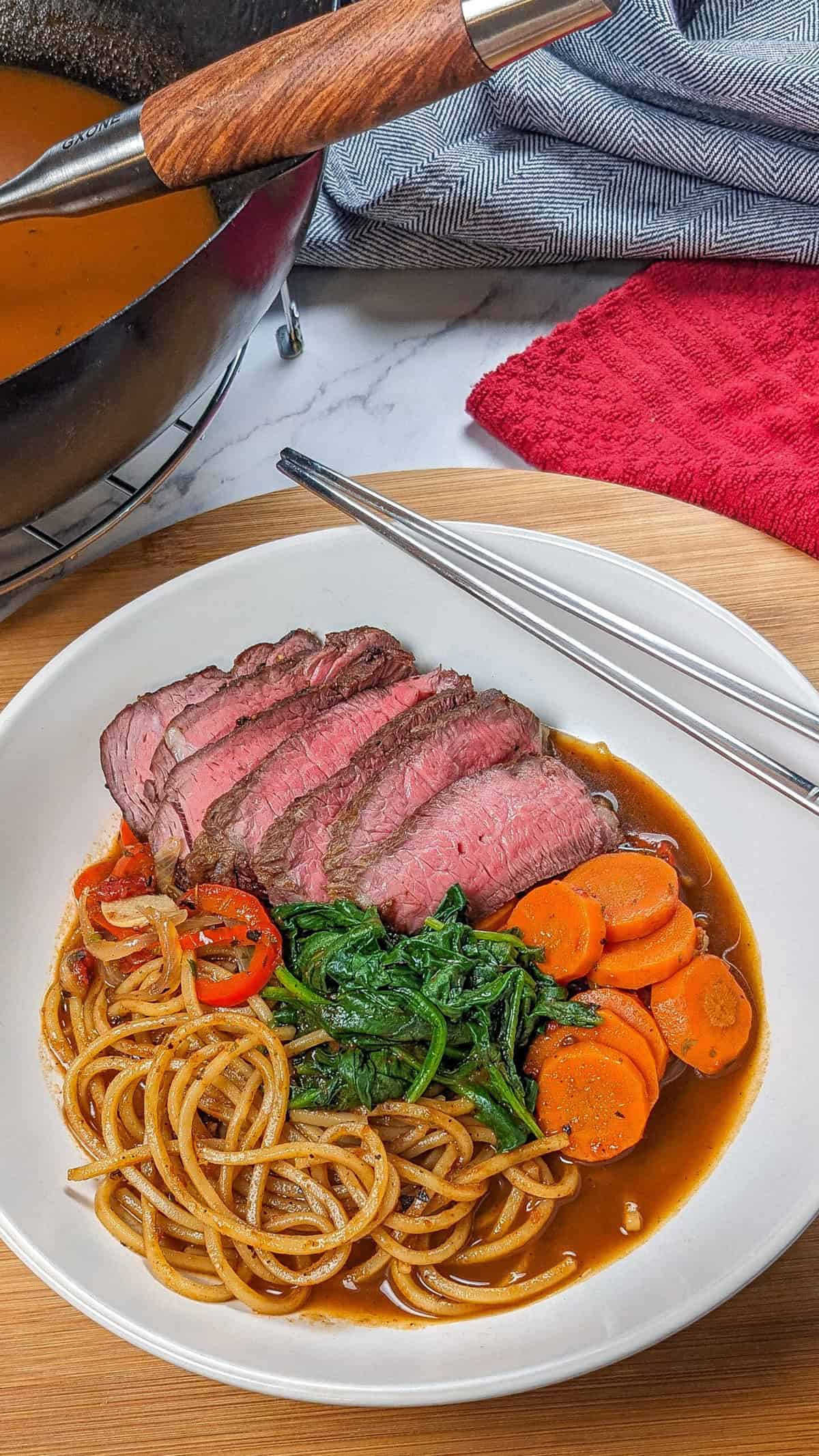
Table of Contents
Jump to:
- Caribbean Spices and Classic Comfort
- What Makes This Special?
- Beef Noodle Soup: Vietnamese, Taiwanese, and Chinese
- The Vietnamese Influence
- The Haitian Influence
- Why Spaghetti?
- The Truth About Ramen Broth
- Seared Steak vs. Braised Beef
- Ingredients with Steps
- Culinary Glossary
- Instructions with Pictures
- Substitutions
- Variations
- Equipment
- Storage and Reheating
- Cooking Tips
- Frequently Asked Questions
- Beef, Lamb, and Pork Recipes
- Soups and Stews Recipes
- 📖 Recipe
- Subscribe to the YouTube Channel
- Have a Comment or Question?
Caribbean Spices and Classic Comfort
The inspiration for my Bold and Spicy Caribbean Beef Noodle Soup Recipe Twist comes from a deep love for blending vibrant Caribbean spices with classic comfort food. Imagine this: tender beef, fiery scotch bonnet peppers, and noodles simmering together in a rich, flavorful beef broth.
It's like a warm Caribbean hug in a bowl but with an extra kick of heat! This dish is perfect for novice home cooks who want to explore bold flavors without feeling overwhelmed. I've made it simple, fun, and full of tips to help you feel like a pro in the kitchen-trust me, this is one soup you'll want to make on repeat.
What Makes This Special?
It's not your typical beef noodle soup. Inspired by the bold flavors of the Caribbean, it brings the heat with scotch bonnet peppers, a burst of freshness with fire-roasted tomatoes, and the richness of beef bone broth.
It doesn't matter if you're cooking for a family dinner or just satisfying your own craving for something hearty and flavorful; this Caribbean beef noodle soup is sure to be a hit, even for those new to the kitchen. Plus, the step-by-step guidance ensures success every time!
Beef Noodle Soup: Vietnamese, Taiwanese, and Chinese
Vietnamese
Better known as pho, Vietnamese beef noodle soup is a beloved dish with a rich history rooted in French and Chinese influences. It's made up of rice noodles, thinly sliced beef, and a delicate broth infused with star anise, cinnamon, cloves, and fish sauce.
The broth itself is not spicy, but diners can customize their bowls with fresh herbs, lime, and chili for a kick of heat. Pho is all about balance-warm, aromatic, and slightly sweet, with a focus on fresh ingredients that enhance the beef flavor.

Looking for authentic Vietnamese recipes? Check out The Little Kitchen and Vicky Pham.
Taiwanese and Chinese
On the other hand, Taiwanese beef noodle soup brings a bolder, more intense flavor profile. Typically made with thick wheat noodles, chunks of beef shank, and a deep, dark broth, it leans on soy sauce, fermented bean paste, and Chinese five-spice to create a richer, more savory experience.
Unlike pho, Taiwanese beef noodle soup can be inherently spicy, with chili oil often being a key ingredient. Lastly, Chinese beef noodle soup tends to vary by region, but a common thread is its use of chewy wheat noodles, braised beef, and soy-based broth that's more subtly spiced compared to its Taiwanese counterpart.

Looking for authentic Chinese and Taiwanese recipes? Check out Greedy Girl Gourmet and Tiffy Cooks. Head over to The Beef on Beef Noodle Soup from Taiwan Panorama for a classic article on Taiwan beef noodle history. Next, head over to Chinese Cooking Demystified Substack: Noodle Soup 101.
The Vietnamese Influence
Now, focusing on the recipe at hand, Vietnamese beef noodle soup inspired aspects of this Caribbean beef noodle soup in several ways. Both soups celebrate tender beef simmered in a flavorful broth, but while pho relies on delicate aromatics, this recipe takes a more bold and spicy approach.
Adding scotch bonnet peppers, parsley, and fire-roasted tomatoes brings a Caribbean flair, creating a richer, more robust broth. Where pho uses rice noodles, this dish incorporates a heartier noodle to stand up to the intensity of the spices and the thickness of the beef broth.

Get deep into The History and Evolution of Pho: A Hundred Years' Journey on the Pho Forums. Then head over to Vietnam.Travel's The story of Vietnamese pho.
The similarity lies in the comforting nature of a noodle soup that's perfect for sipping, but the Caribbean version packs an extra punch of spice and depth.
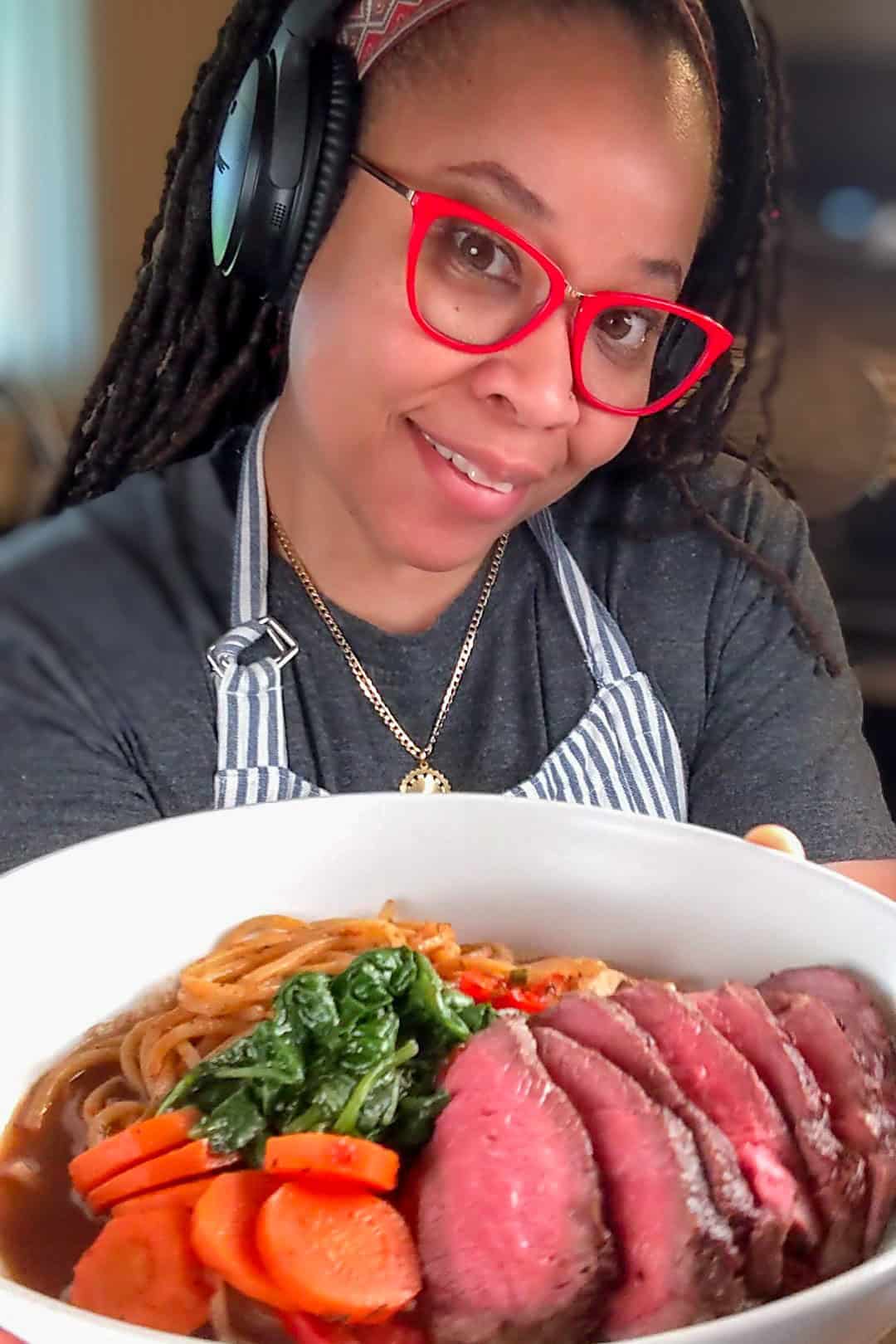
The Haitian Influence
This recipe also draws inspiration from Haitian cuisine, particularly the traditional dish bouillon. Haitian bouillon is a hearty, rustic soup made with beef, a spicy broth, spinach, carrots, and, of course, scotch bonnet peppers, parsley, thyme, and ground cloves.
The deep, robust flavors of this soup are reflective of Haiti's culinary heritage, which has been shaped by influences from West Africa, France, and the many other nations involved in the island's history.
- West African cuisine brought the love of stews, bold spices, and leafy greens, while French colonization introduced dishes like pot-au-feu, a French beef stew that clearly influenced the development of Haitian bouillon.
- The French version is much milder, but in Haiti, it's been adapted with local ingredients like scotch bonnet peppers, turning it into a spicier, more vibrant dish.
This recipe captures that same spirit by using a hearty beef broth infused with traditional Caribbean and Haitian ingredients, adding depth and heat while paying homage to the rich history behind Haitian cuisine.

Looking for authentic Haitian recipes? Check out Sendy's Cookin and Savory Thoughts. Also, check out the Brief History of Haitian Bouillon… by Travelmaker Kai.
Why Spaghetti?
For this recipe, I chose spaghetti as a nod to the beloved Haitian spaghetti dish, a simple but flavorful meal that's a staple in many Haitian households. In Haitian cuisine, it's common to add "espageti" (spaghetti) or "makaroni" (macaroni)-a long, tube-like pasta with ridges-to soups, adding both heartiness and texture.
By using spaghetti in this Caribbean beef noodle soup, I'm not only honoring that tradition but also making the dish more accessible for home cooks who are likely to have spaghetti in their pantry. It bridges the gap between Caribbean flavors and ingredients typically found in an American household, adding a creative twist to the recipe.
The Truth About Ramen Broth
A good ramen broth, on the other hand, is all about depth and umami. Traditionally, ramen broth is made by simmering ingredients like pork bones, chicken, dried kombu (kelp), shiitake mushrooms, and dried fish, creating layers of flavor over several hours.
The gelatin from the bones gives it that rich, silky texture, while the kombu and dried fish contribute a deep umami flavor. Soy sauce, miso, or tare (seasoning paste) is often added to build complexity. The broth is what makes or breaks a good ramen, providing the foundation for the noodles and toppings to shine.
For a quicker version like this spicy beef noodle soup, we're leaning into a flavorful beef bone broth spiced up with Caribbean ingredients, giving a nod to ramen's rich tradition while keeping the process simple.
Seared Steak vs. Braised Beef
When it comes to using seared steak instead of braised, it's all about time and texture. Seared steak brings a beautiful caramelization that adds an extra layer of flavor in a fraction of the time it would take to braise.
While braising would make the beef fall-apart tender, searing creates a more toothsome texture, with the steak slices offering a satisfying bite alongside the tender noodles and vegetables.
Plus, it saves time without sacrificing the richness and depth you'd expect from a slow-cooked meal, making this dish a quick but impressive dinner option for any night of the week.
More Delicious Recipes to Inspire You
- Instant Pot Spicy Beef Barley Stew: Hearty Comfort (popular)
- Grilled Steak Spicy Chimichurri Baby Potatoes and Broccoli
- Pan-Seared Sirloin Steak with Spicy Baharat Sauce
- Beef Flavored Seaweed Ramyun with Egg
- Easy 15-Minute Marinade for Beef Kabobs
Ingredients with Steps
To get that perfectly cooked steak, especially with thicker cuts, finish it in the oven after searing. If your steak is thicker than 1.5 inches, preheat your oven to 375°F (190°C). Heat a wok over medium-high heat with a splash of olive oil, and while it's warming up, season your steak generously with salt and pepper.
Sear each side for 3-4 minutes until you get that golden-brown crust. For thicker cuts, pop the steak into an oven-safe dish and let it finish in the oven, aiming for an internal temp of 125-130°F for medium-rare or 135-140°F for medium.
Now, while your steak rests, keep the wok hot. Sauté onions, green bell peppers, garlic, and a fiery scotch bonnet until everything softens. Add in some fire-roasted tomatoes, dried thyme, ground clove, and parsley to build the base of that bold, spicy beef broth. Pour in beef bone broth, bring it all to a boil, and cook the spaghetti, carrots, and spinach until they're perfectly tender.
Once your steak is rested, slice it up, and serve the soup with noodles, broth, veggies, and tender steak on top. Garnish with fresh parsley and a squeeze of lime for a bright, zesty finish.
Culinary Glossary
This section provides concise definitions of key ingredients and techniques to enhance understanding and improve cooking skills related to this recipe. Check out the live Culinary Glossary here.
Ingredients
- Scotch Bonnet Pepper - A small but mighty chili pepper known for its intense heat and fruity flavor, commonly used in Caribbean cuisine -this little fireball brings the heat, but you can adjust the spice level if necessary.
- Beef Bone Broth - A rich, nutrient-dense broth made from simmering beef bones, used as the flavorful base of the soup. The fact that you can just buy this now is amazing; I used Trader Joe's Beef Bone Broth to develop this recipe.
- Fire-Roasted Tomatoes - Tomatoes that have been charred to bring out a smoky sweetness, adding depth to soups and stews.
- Parsley - A fresh herb used to add a bright, clean flavor to dishes, commonly used as a garnish or seasoning, especially in Haitian cuisine.
- Thyme - An herb with an earthy, slightly minty flavor that pairs well with savory dishes, often used in soups and stews.
- Ground Clove - A warm, aromatic spice with a slightly sweet and bitter flavor, used to add depth and a hint of spice to dishes.
- Sirloin Steak - We're using sirloin here because it's tender, flavorful, and easy to cook, but feel free to swap it with ribeye or another steak cut you prefer.
- Spaghetti - A long, thin pasta that is used in this recipe to represent the Haitian tradition of adding pasta to soups.
Technique
- Vegetables & Aromatics - You'll need thinly sliced onions, green bell peppers, and garlic to create the aromatic base to build the broth's flavor.
- The Maillard Reaction - a chemical process that occurs when the steak is seared at high heat, causing the proteins and sugars on the surface to brown and create a rich, savory crust packed with deep, caramelized flavors, essential for enhancing the taste of this Caribbean beef noodle soup.
- Seared Steak - A cooking technique where the surface of the steak is quickly browned at high heat, creating a flavorful crust through caramelization.
See the Caribbean beef noodle soup recipe card for quantities below.
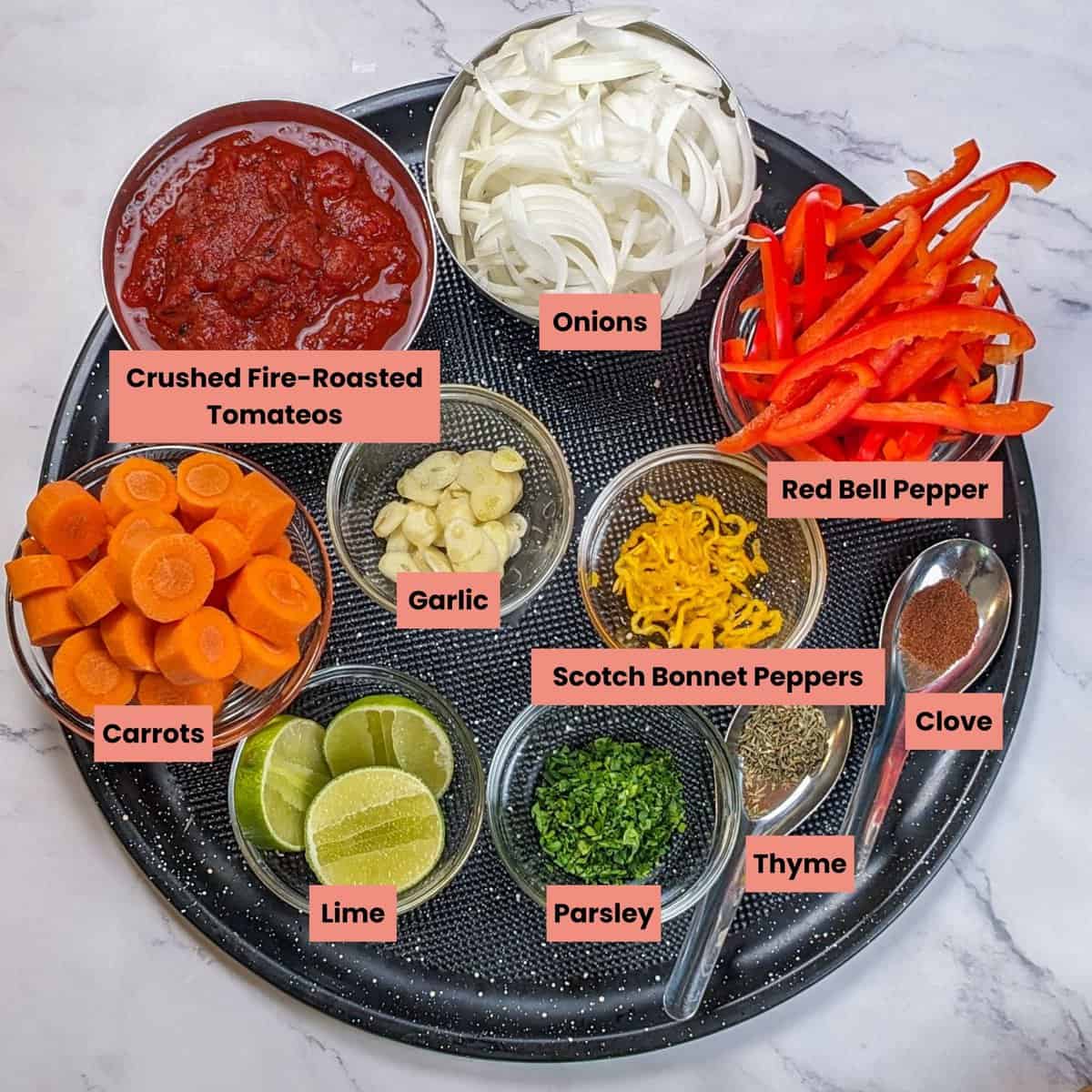
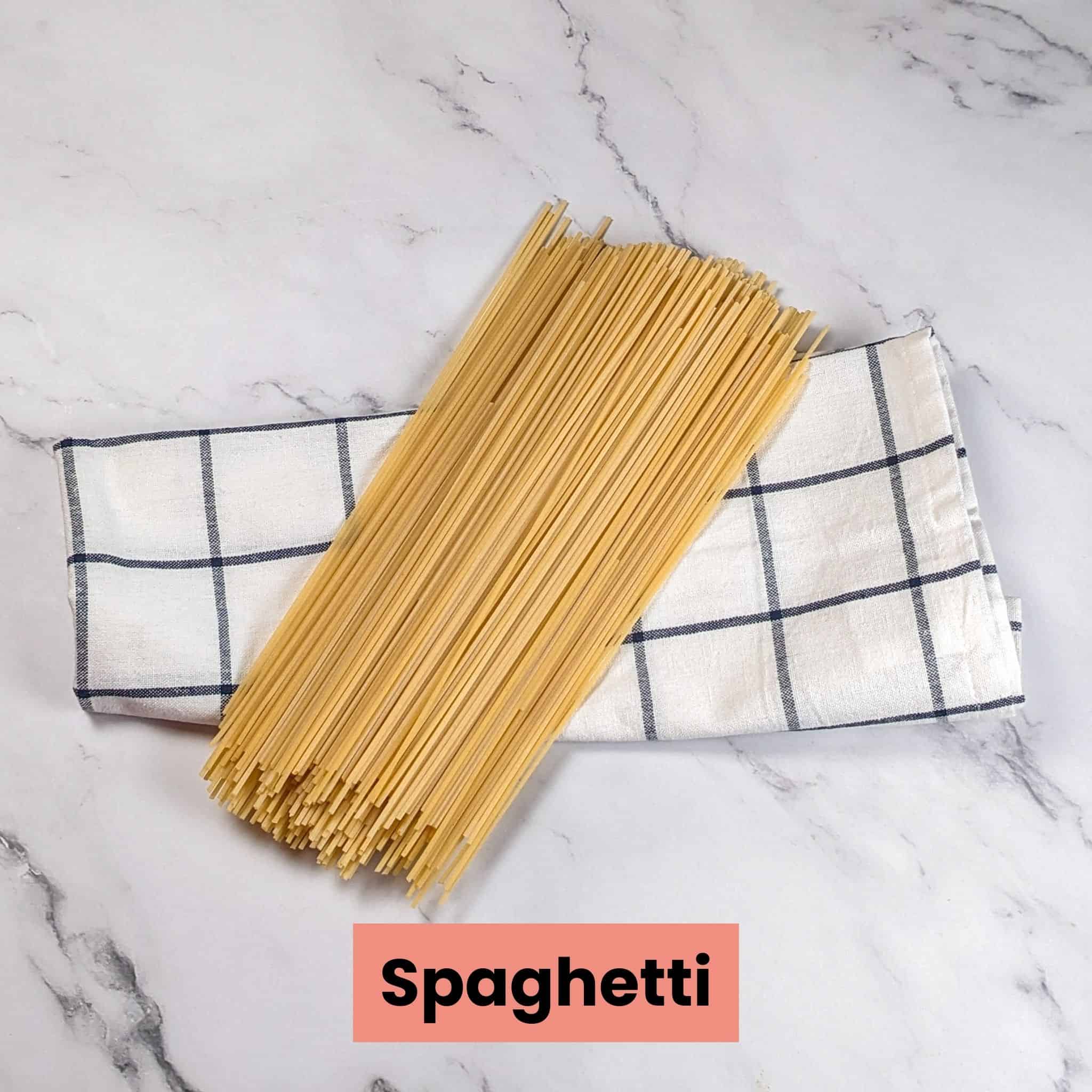

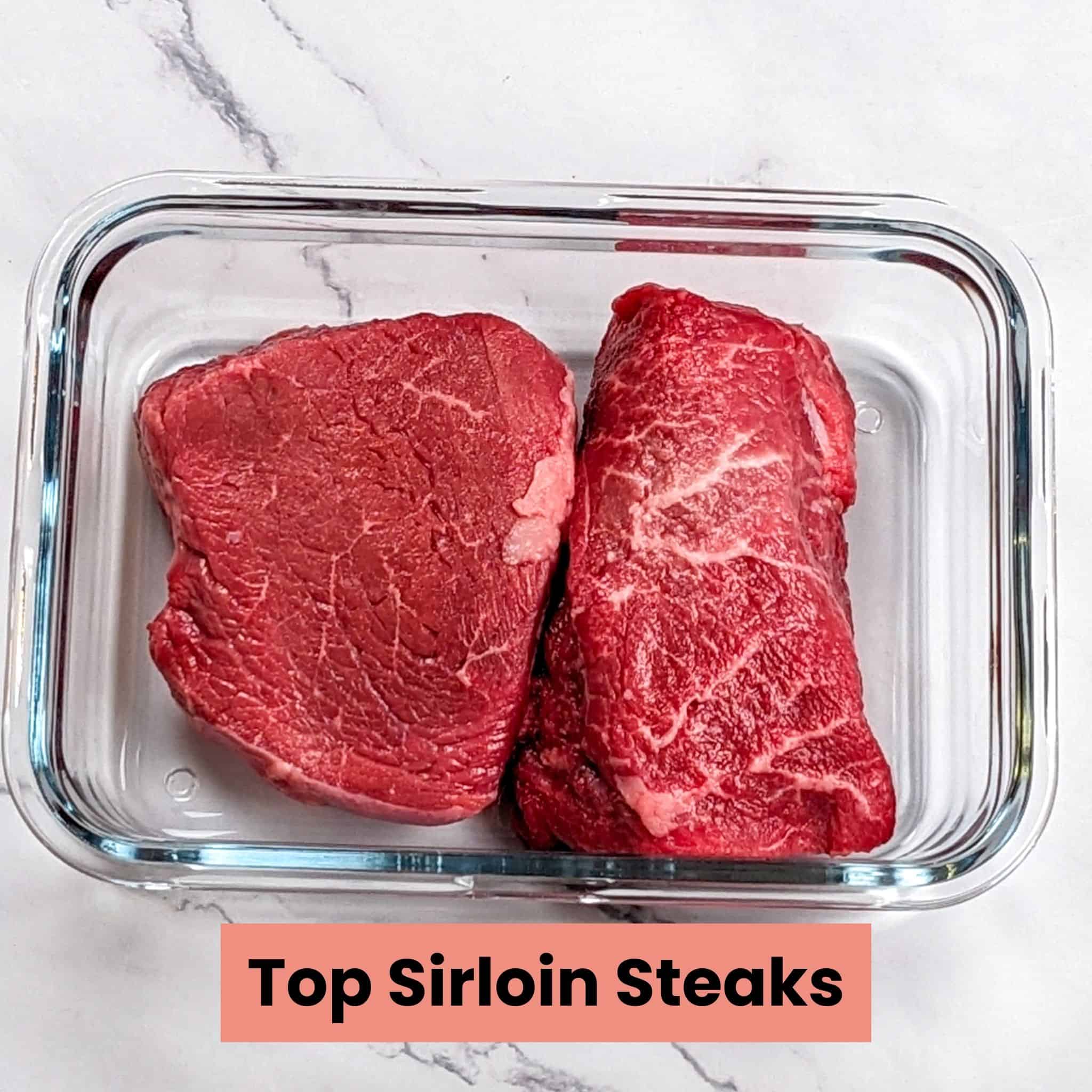
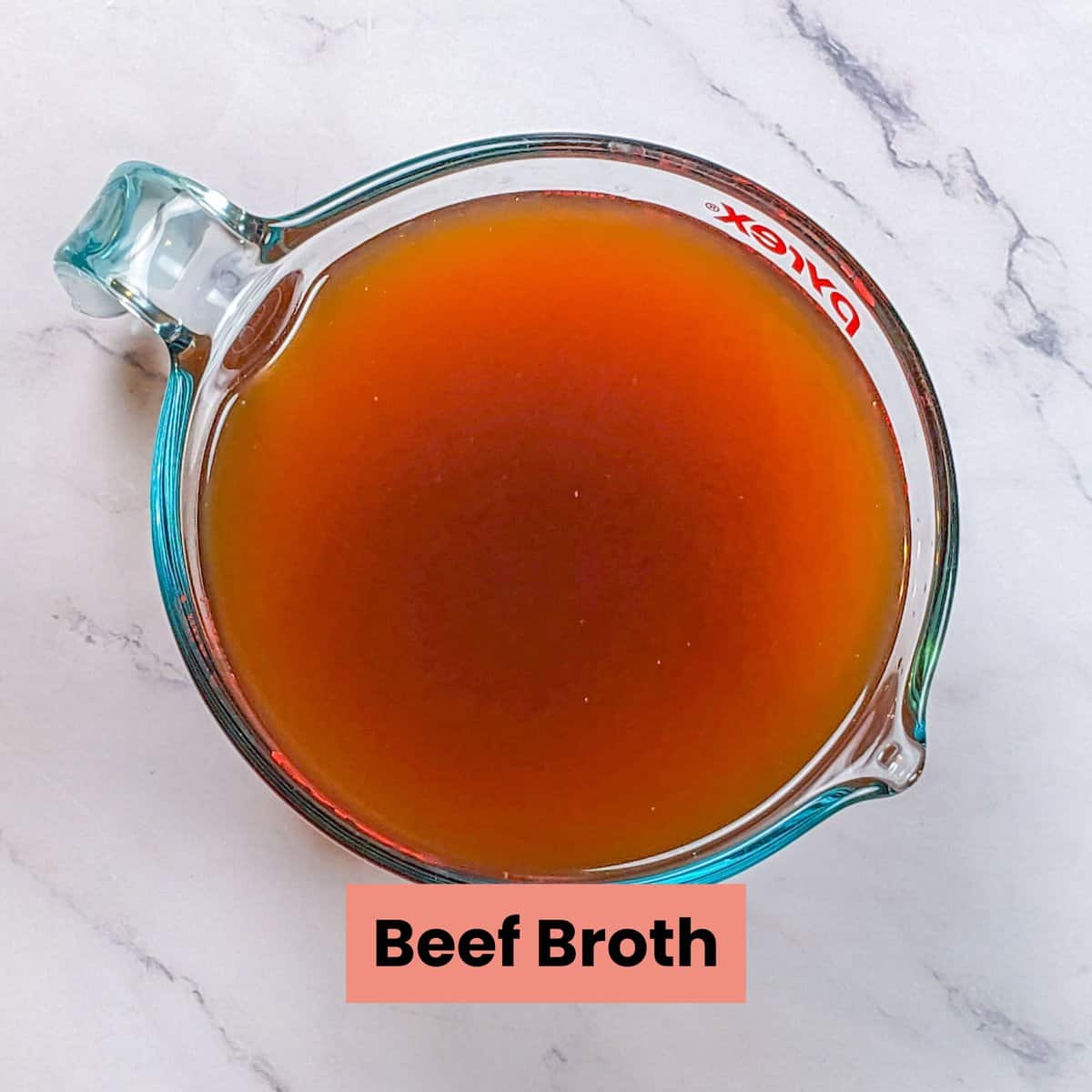
Instructions with Pictures
Follow the instructions and cooking tips below using the step-by-step picture guide. The first rule of thumb for any recipe is preparation. Take a few minutes to gather and prep all your ingredients. Trust me, this will make cooking much easier!
Wok Talk
Follow these tips and tricks when using a wok. Learn more wok tips here.
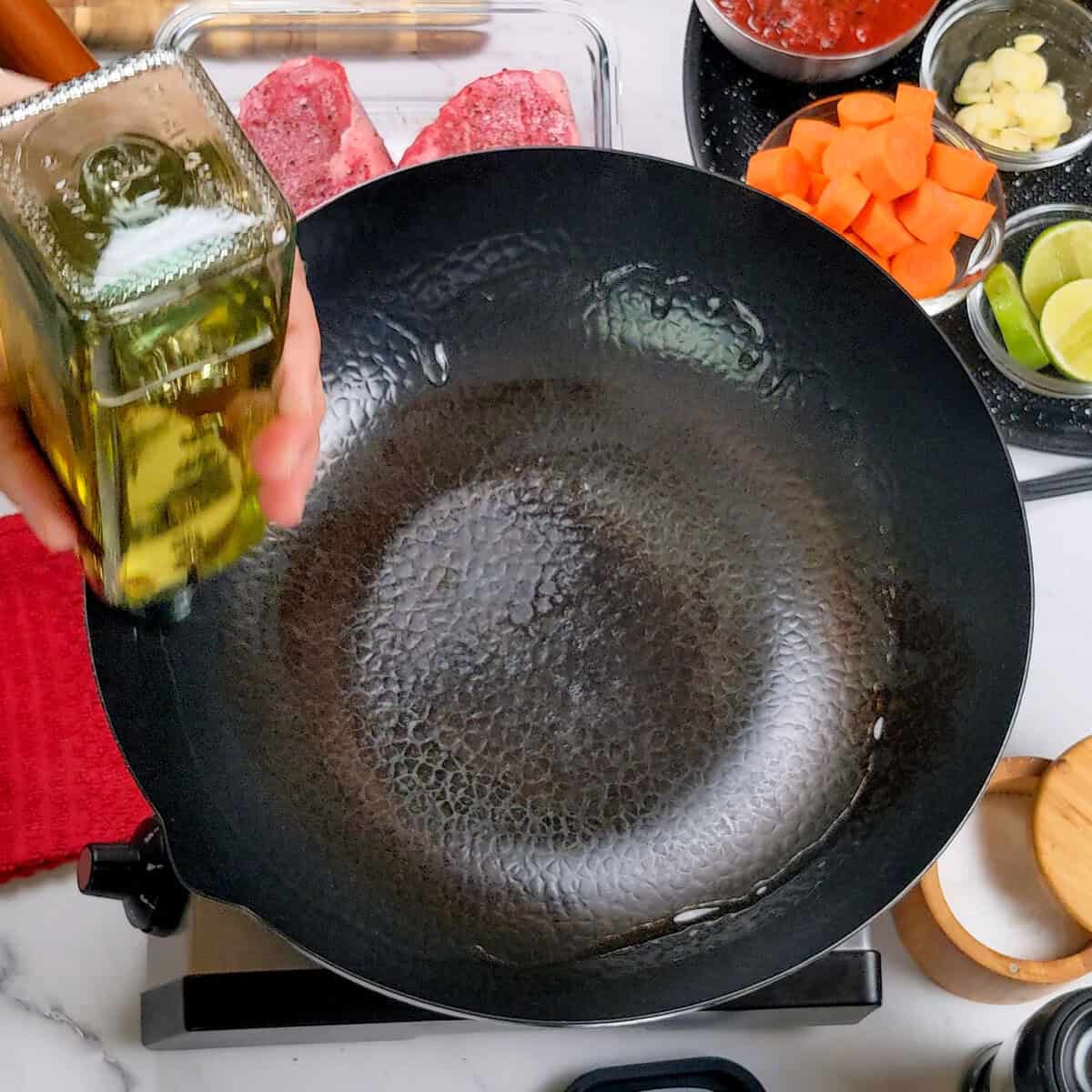
Heat your wok over medium-high heat, then add 1 tablespoon of olive oil.
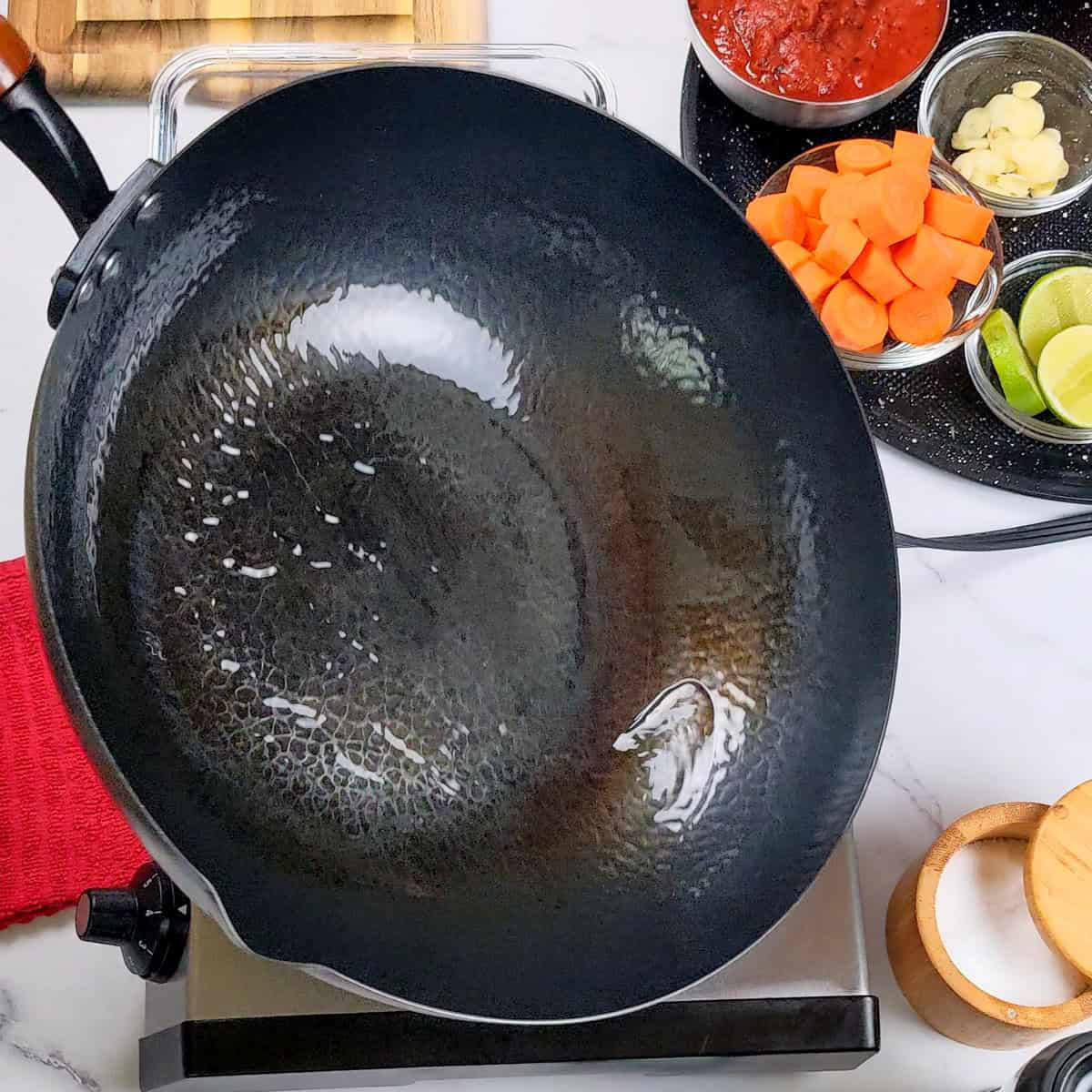
Starting at the top rim, then swirling the cold oil in the hot pan creates a non-stick barrier.
Searing the Steak
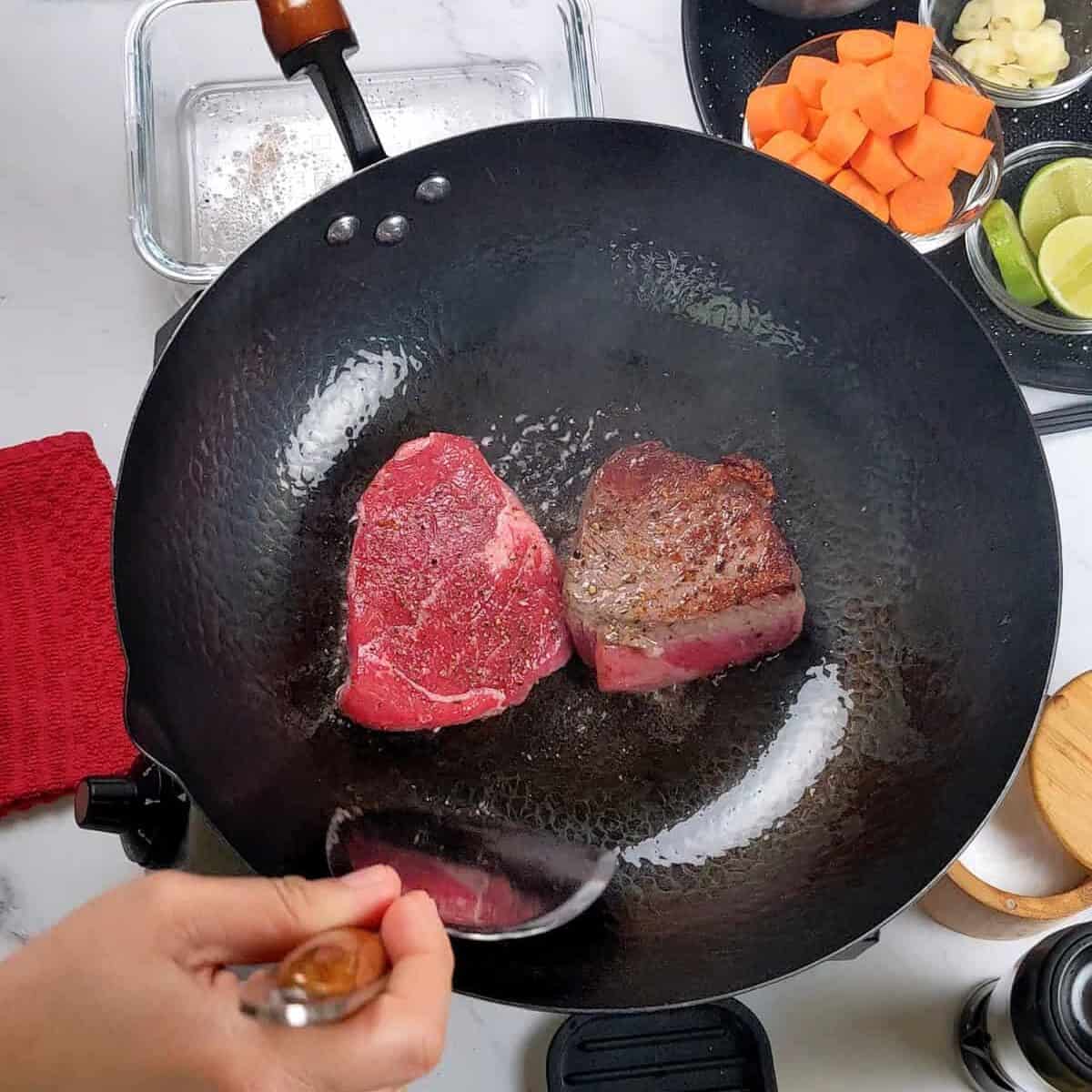
Sear the steak for 3-4 minutes on each side until it has a golden-brown crust.
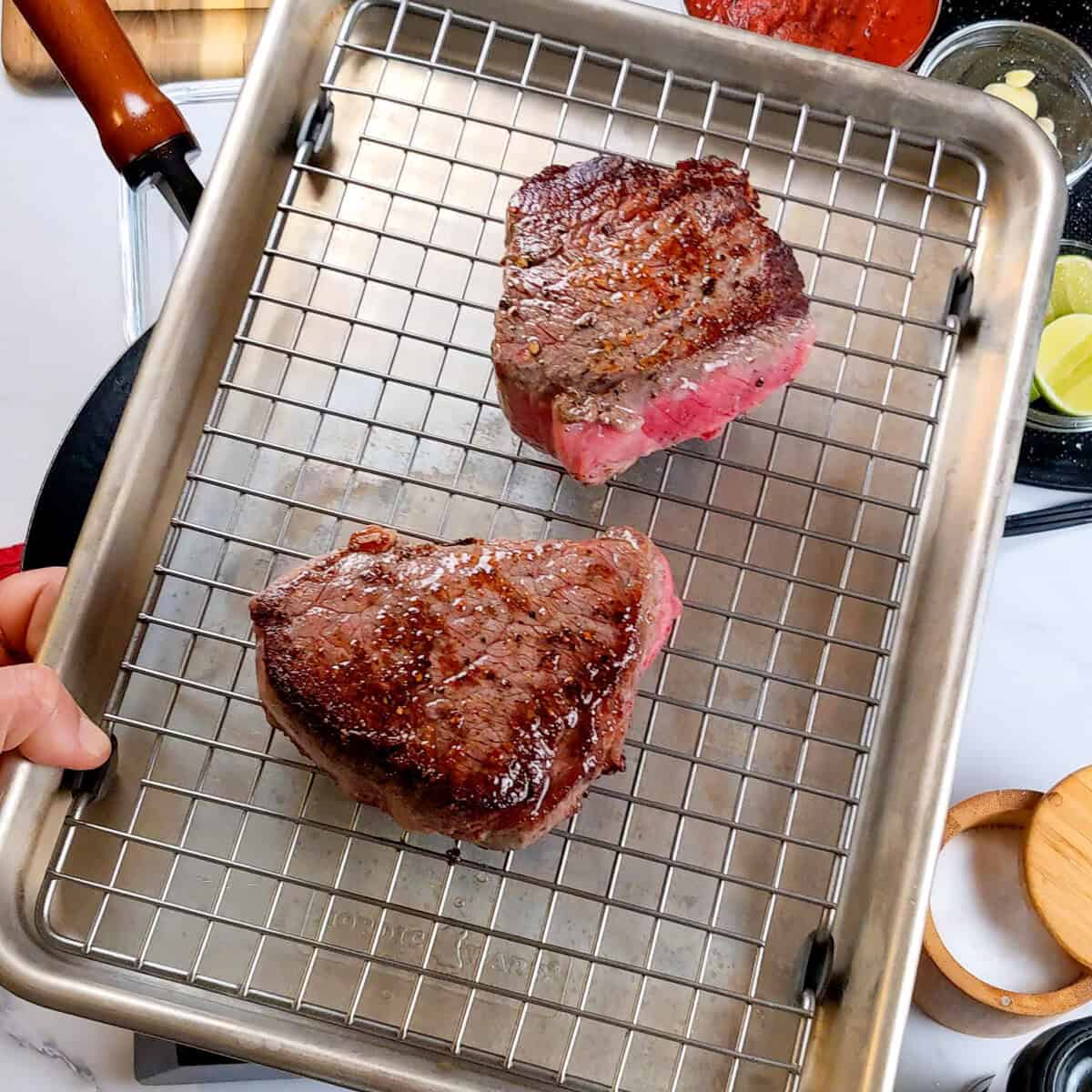
Don't worry about cooking it all the way through right now; we'll finish it in the oven for thick cuts.
Finishing the Steak in the Oven

For steaks thicker than 1.5 inches, transfer them to an oven-safe dish and place them in a preheated oven at 375°F (190°C). Cook until the internal temperature reaches 125-130°F for medium-rare or 135-140°F for medium. Once done, let the steak rest for a few minutes before slicing.
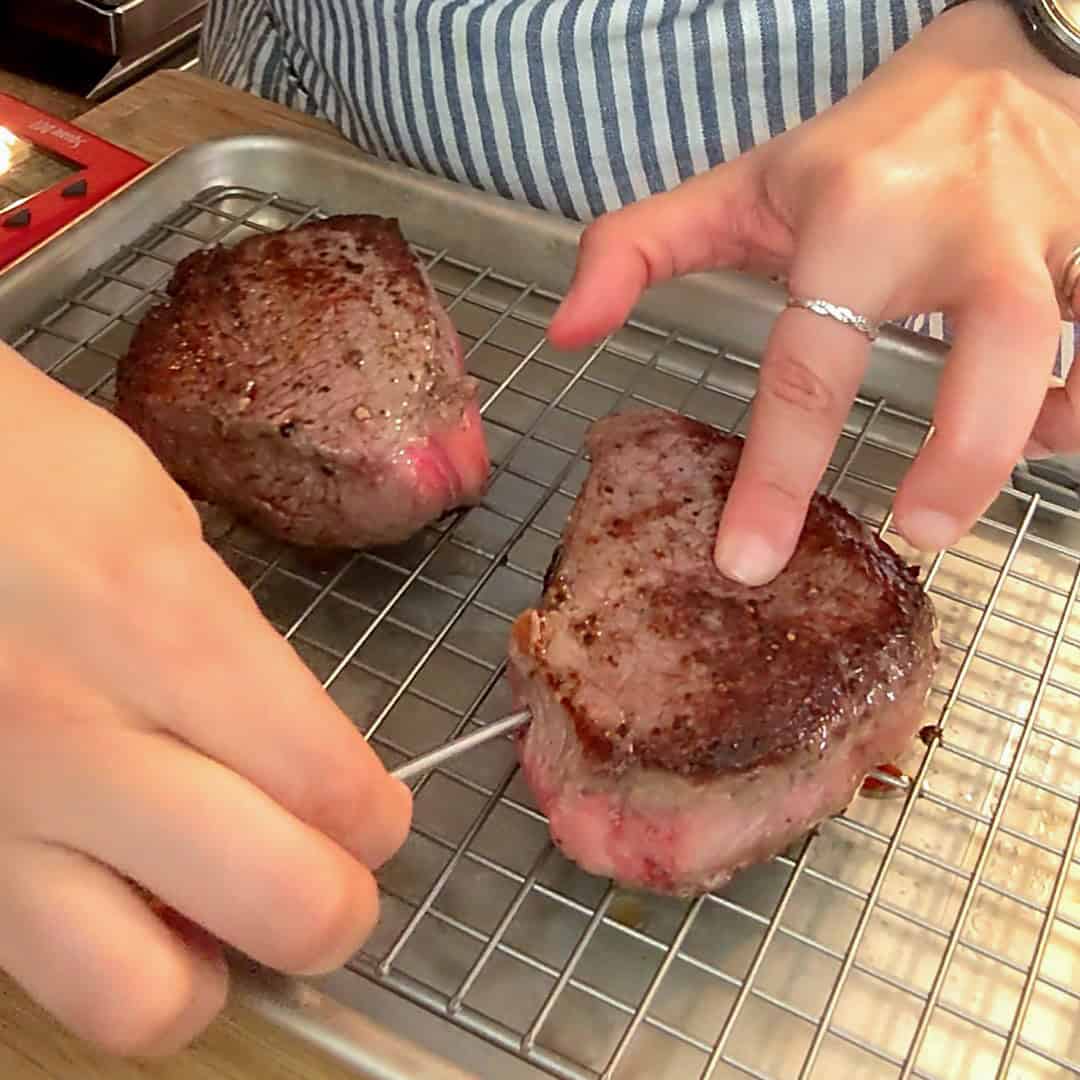
Insert the reader into the center of the steak.
Spicy Beef Broth Base
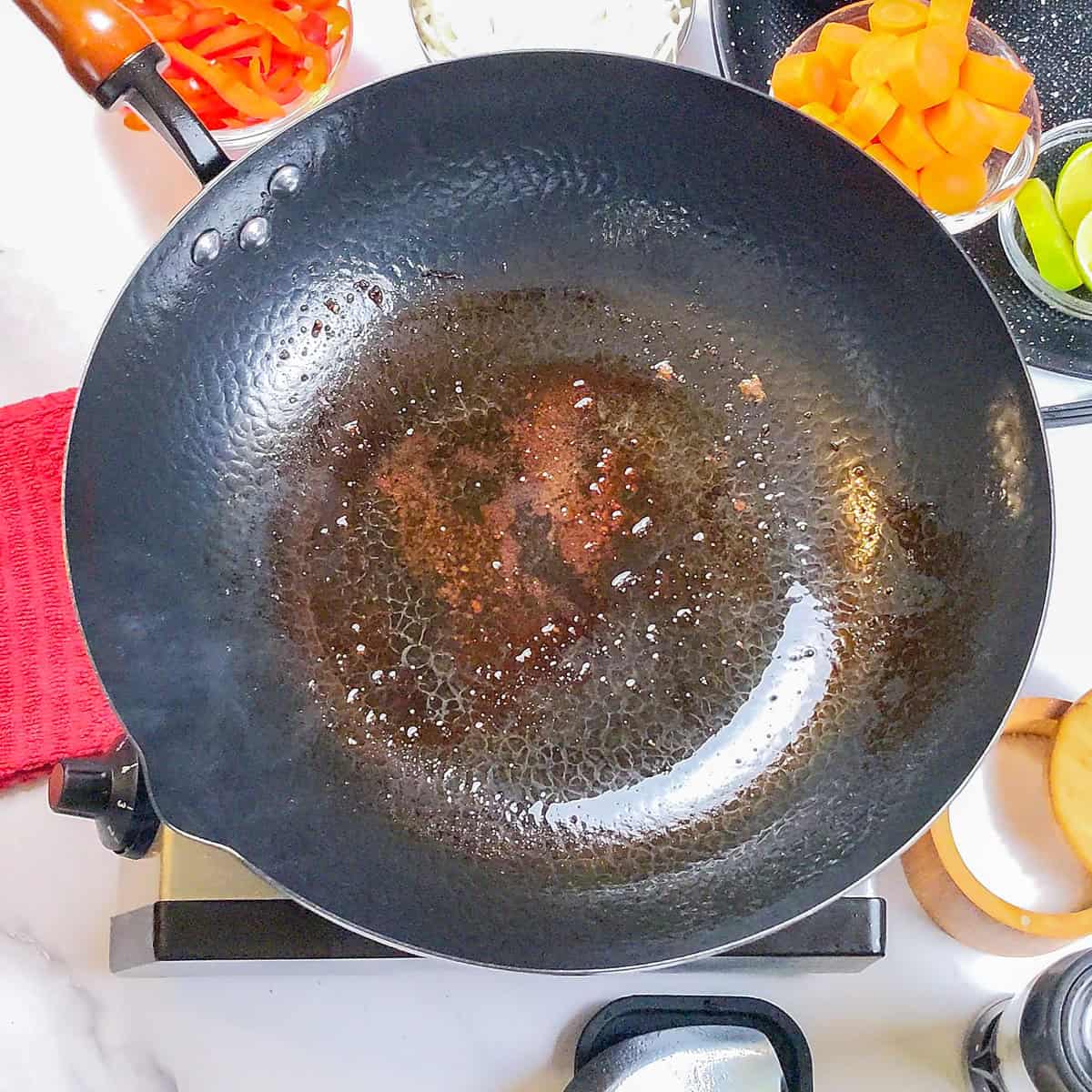
In the same wok, add a bit more olive oil if needed.
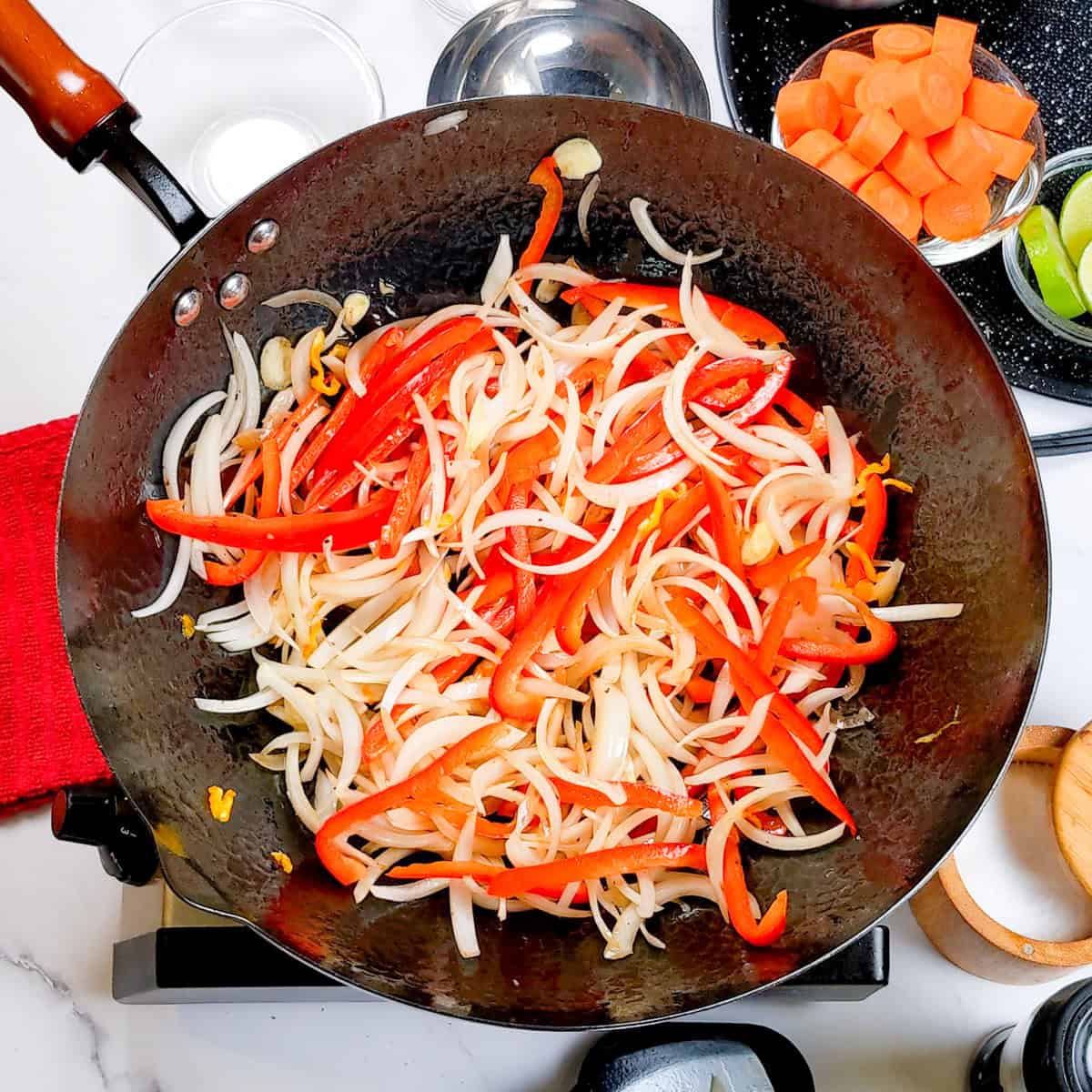
Sauté the onions, green bell peppers, garlic, and scotch bonnet pepper.
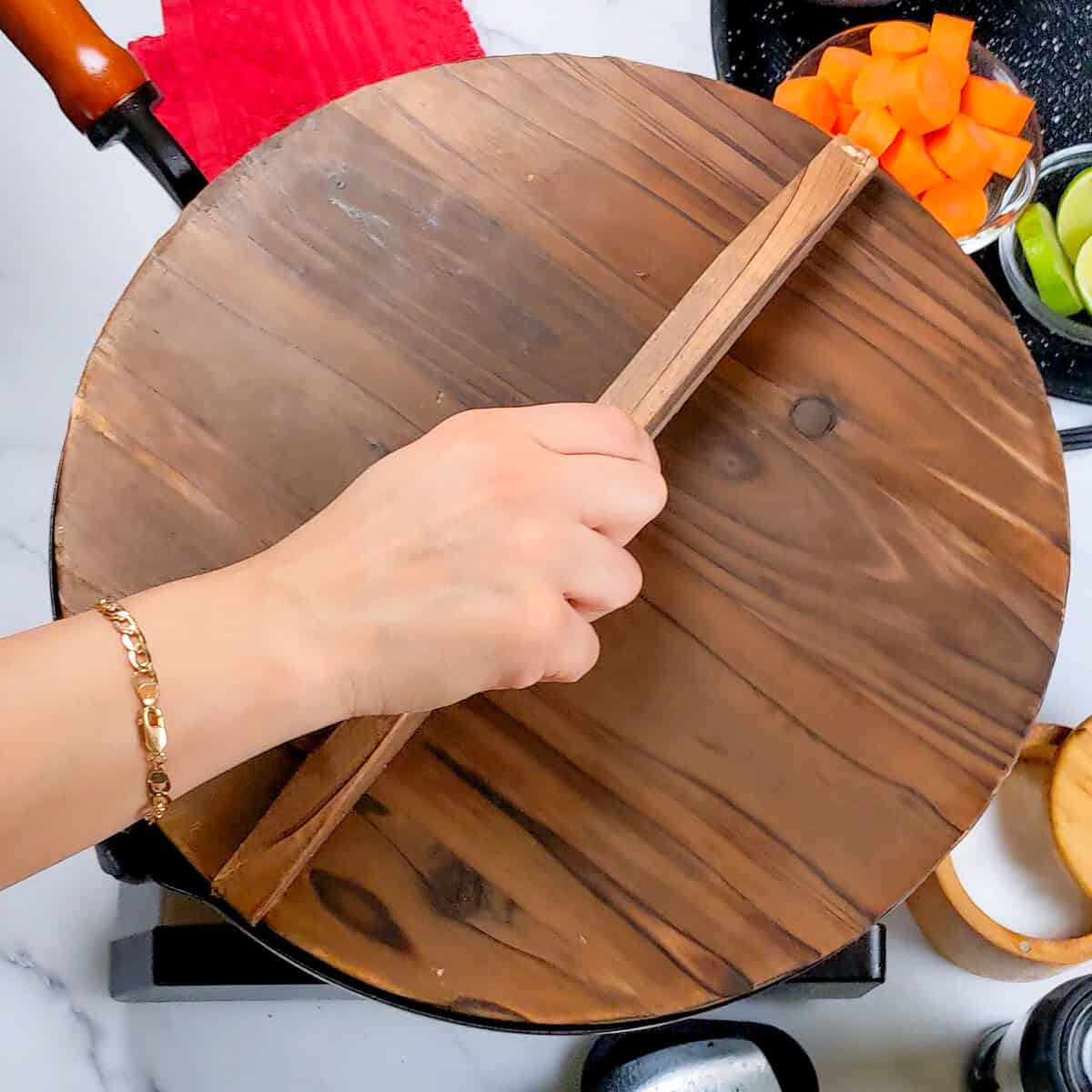
Cover the pan and steam for 4-5 minutes to soften the veggies.
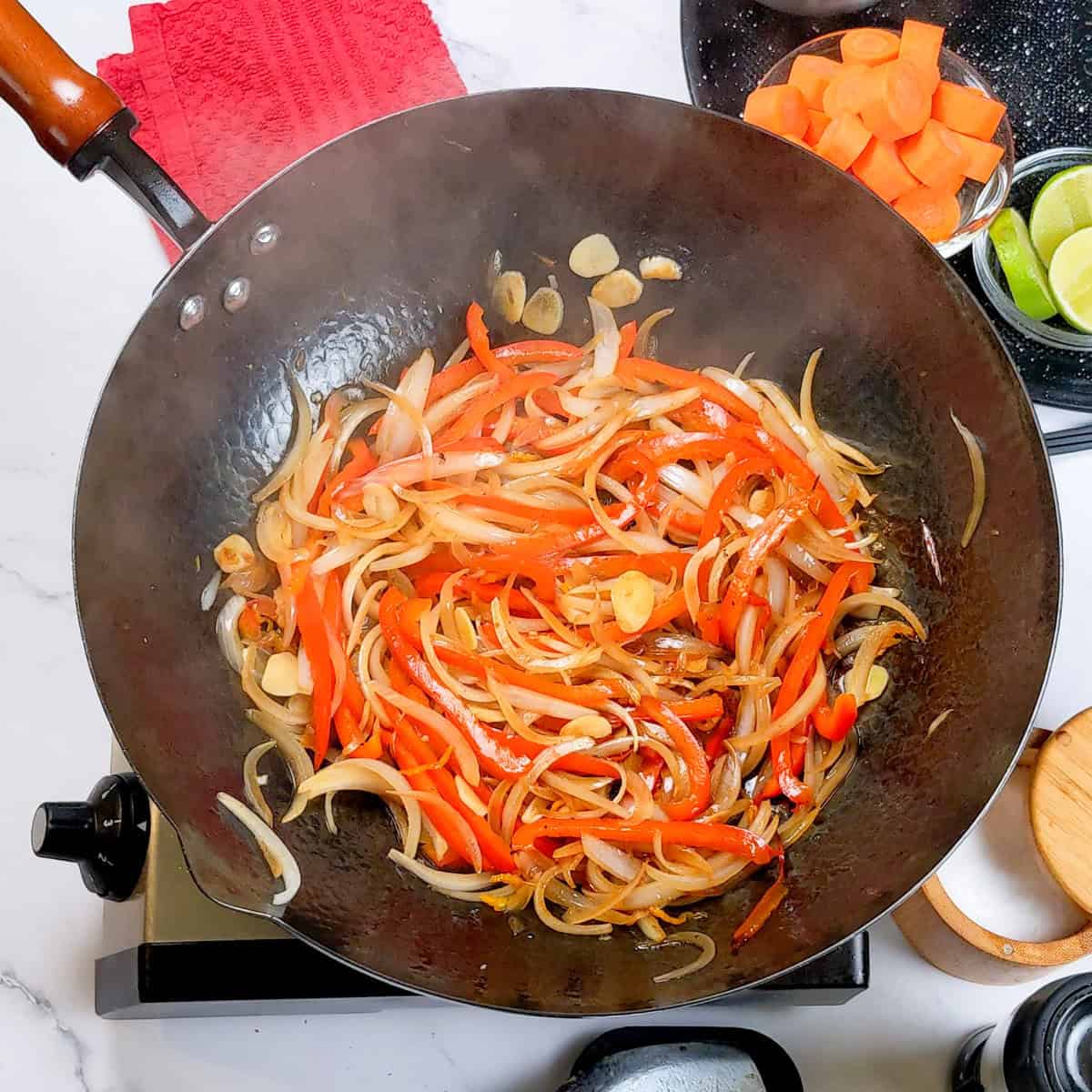
Then, uncover and brown them for another 1-2 minutes.
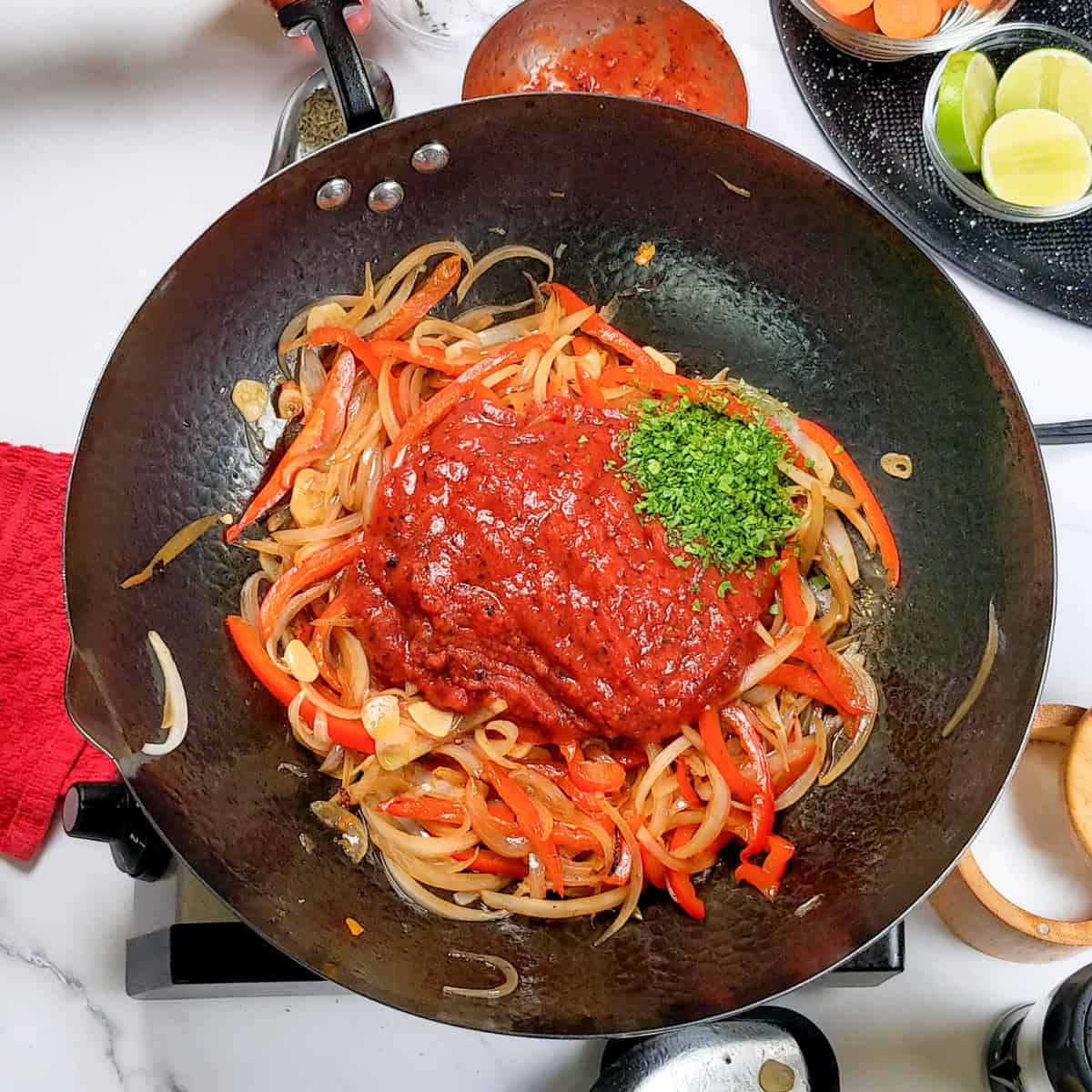
Stir in the fire-roasted tomatoes, thyme, and a pinch of ground clove.
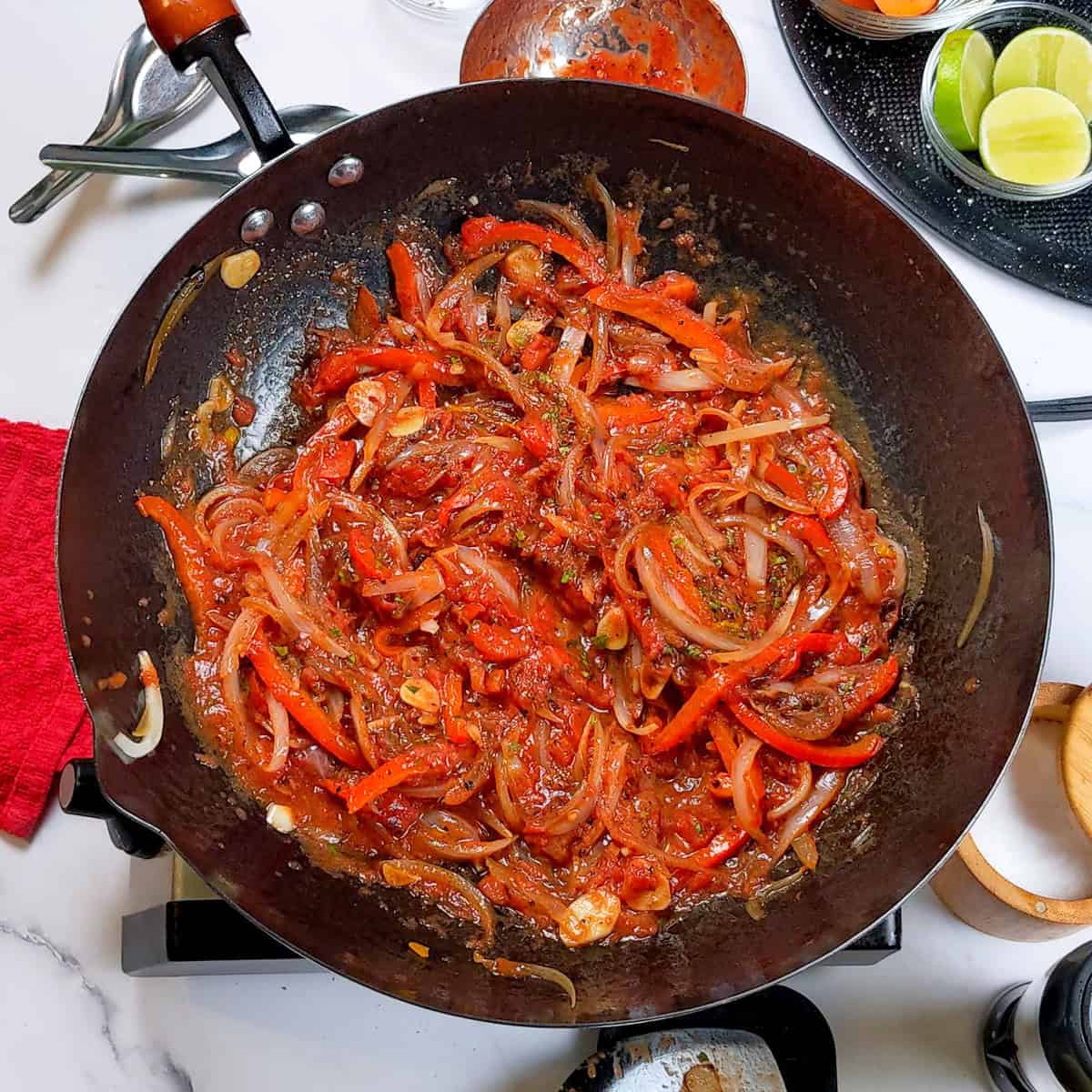
Let these ingredients cook together for 4-5 minutes before adding the beef bone broth.
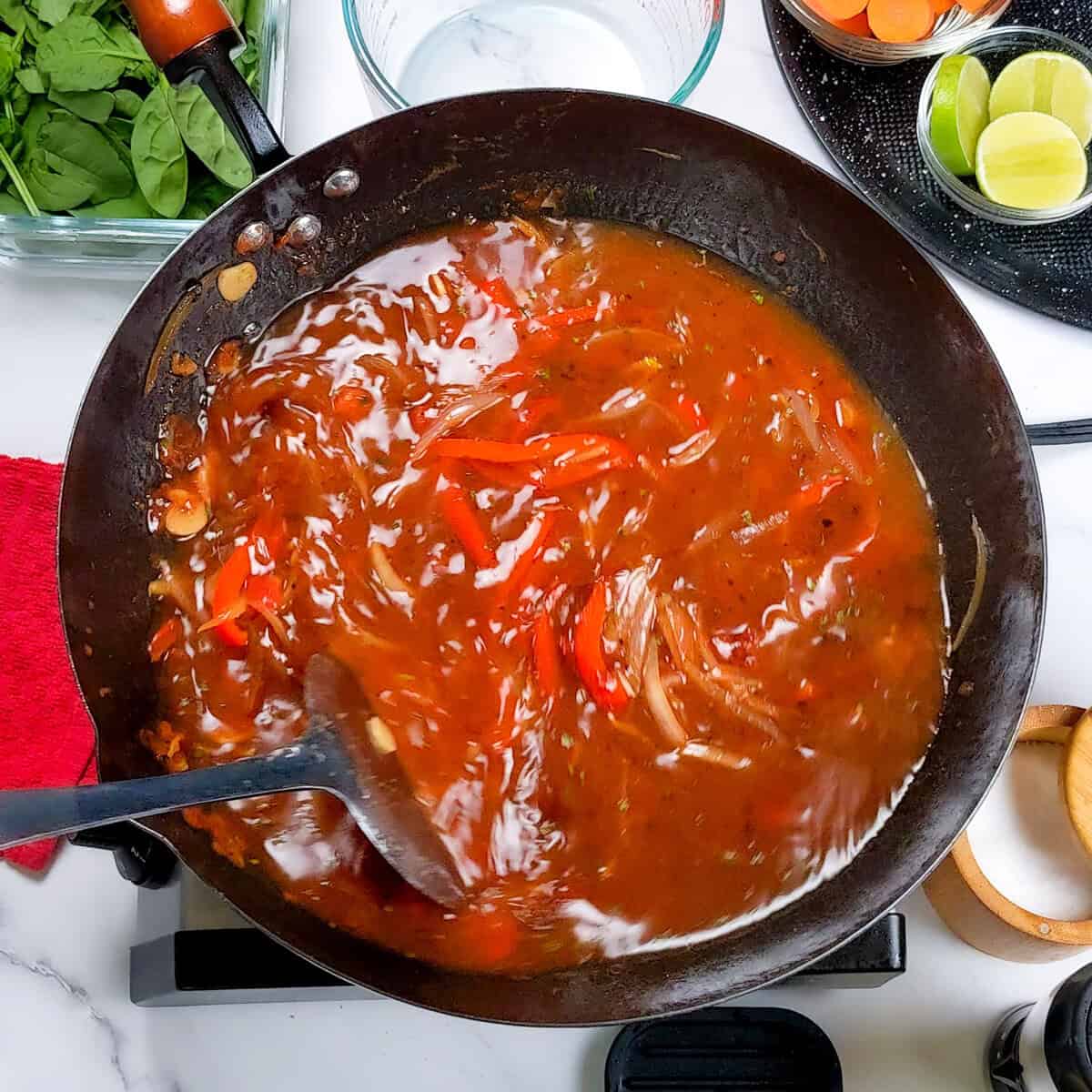
Bring everything to a boil, then season with salt and pepper to taste.
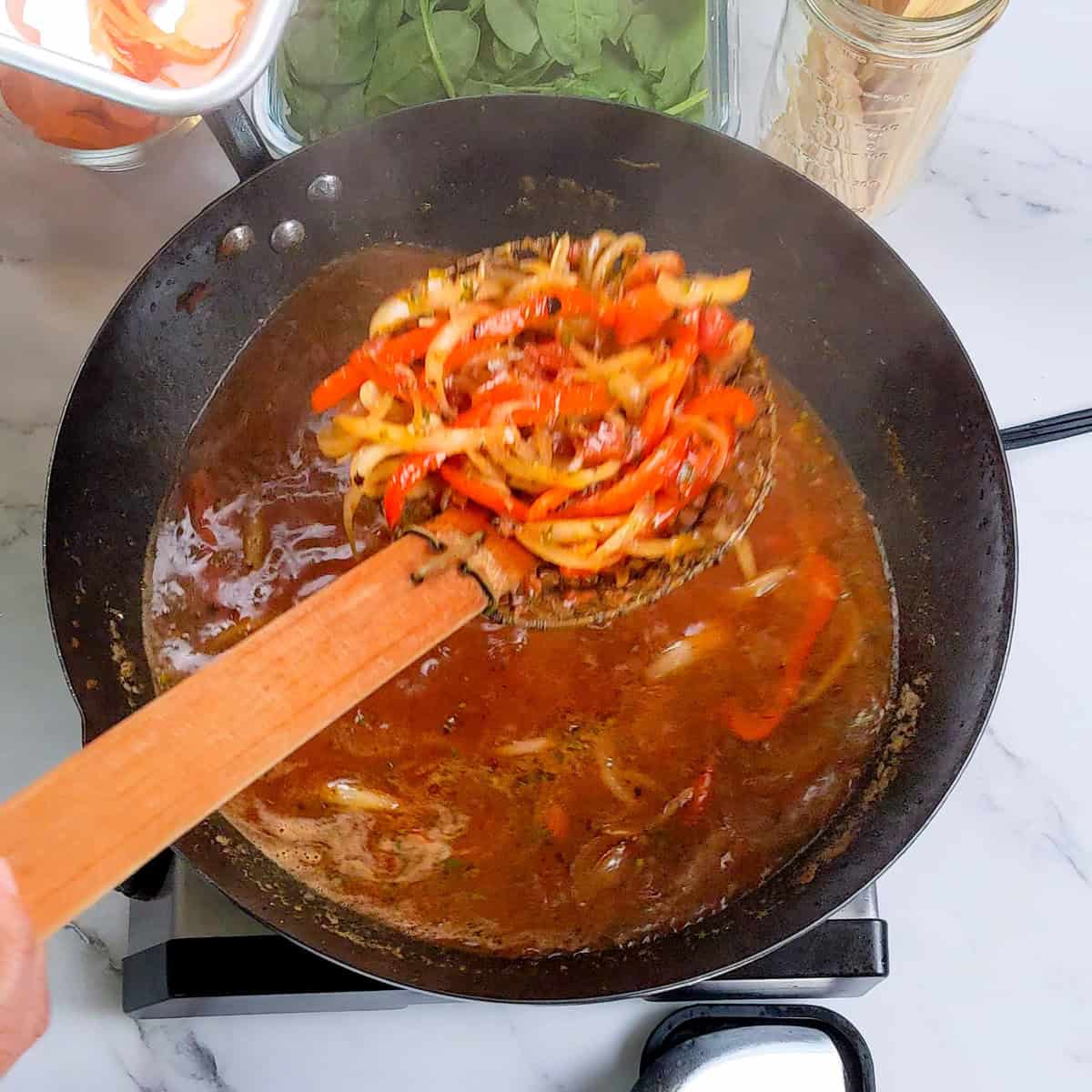
Use a strainer/spider to remove the bell pepper mixture and set it aside.
Finish the Broth
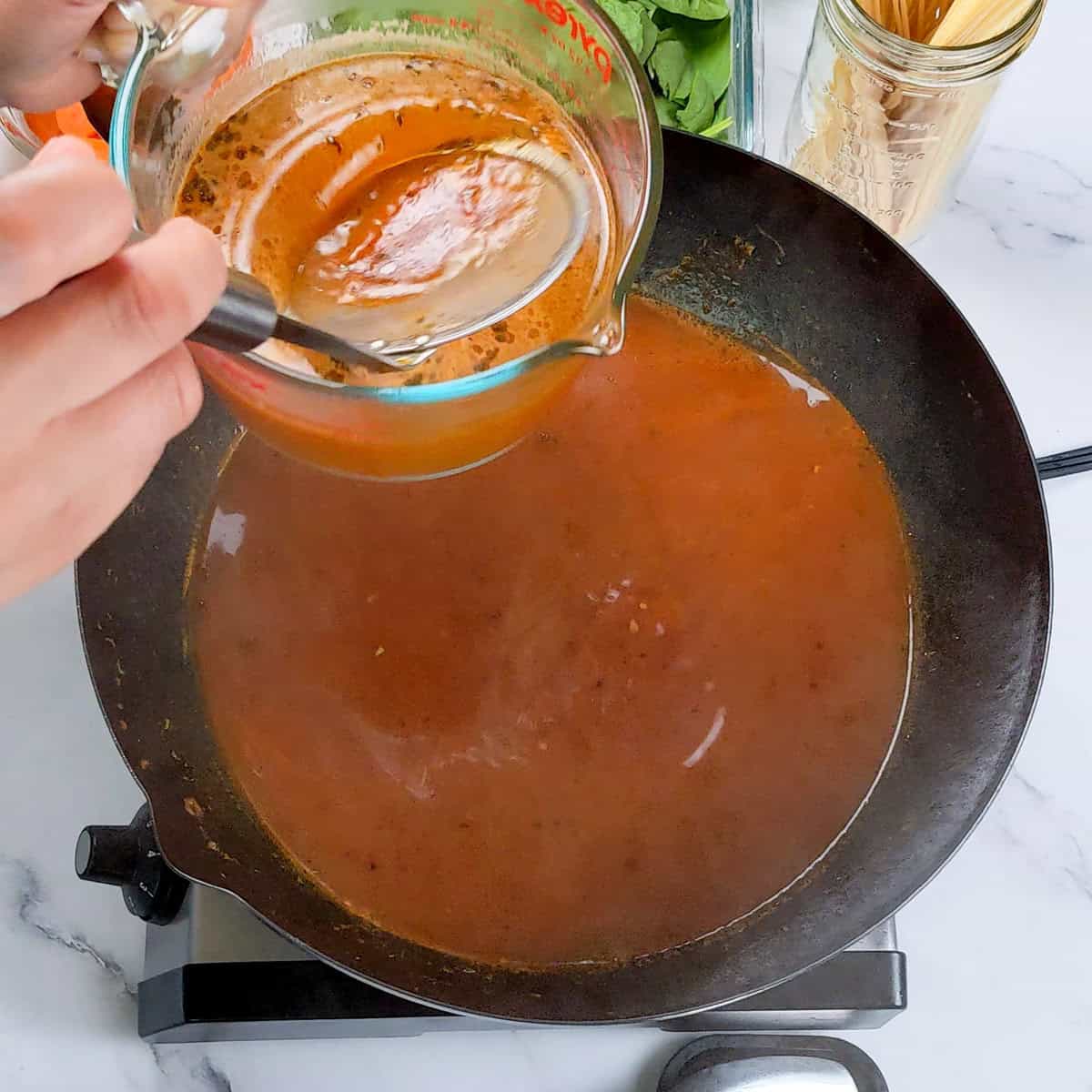
Using a container with water to release the fat also helps during this process.
Vegetables and Noodles
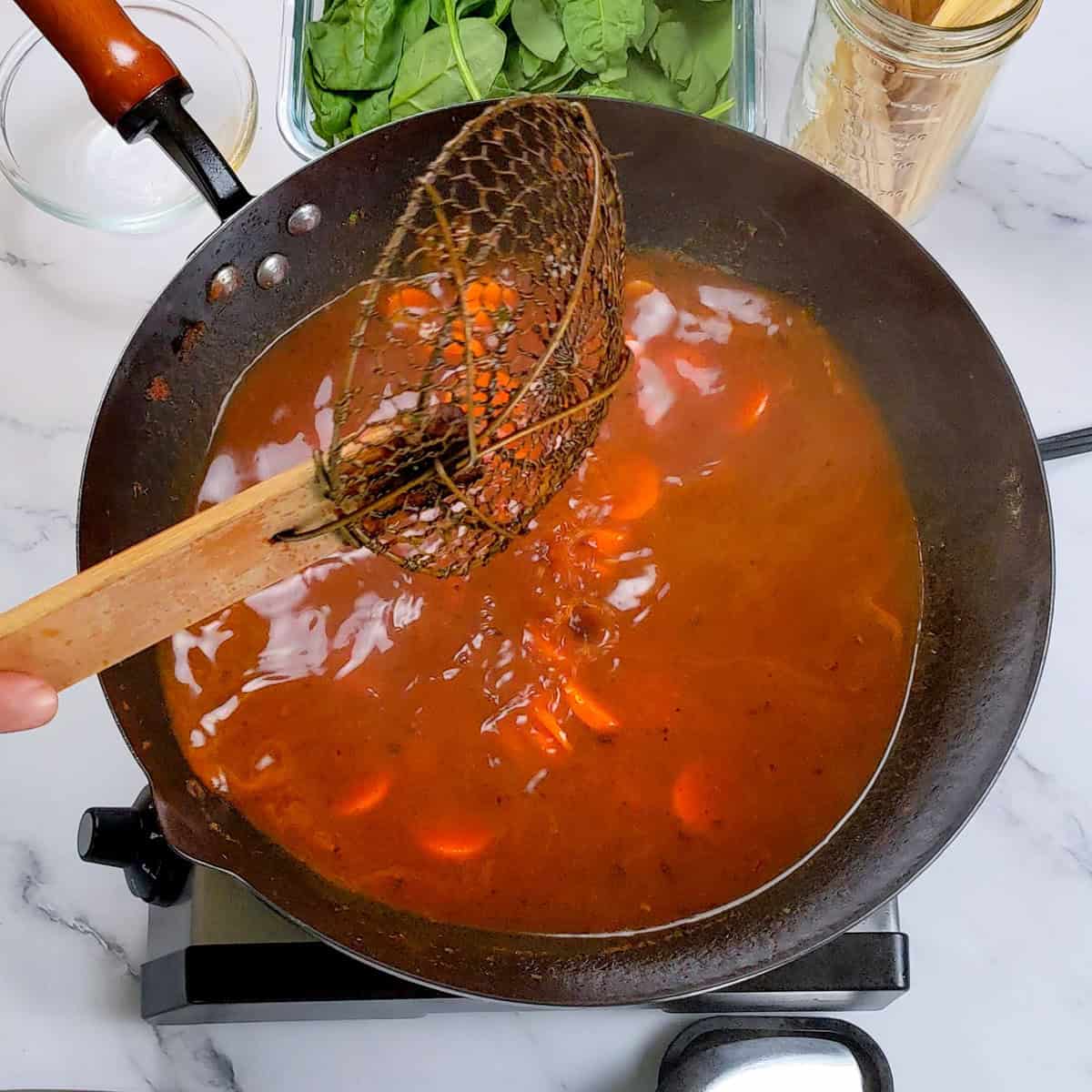
Add thick-sliced carrots to the broth and cook for 5-6 minutes until they're just tender.
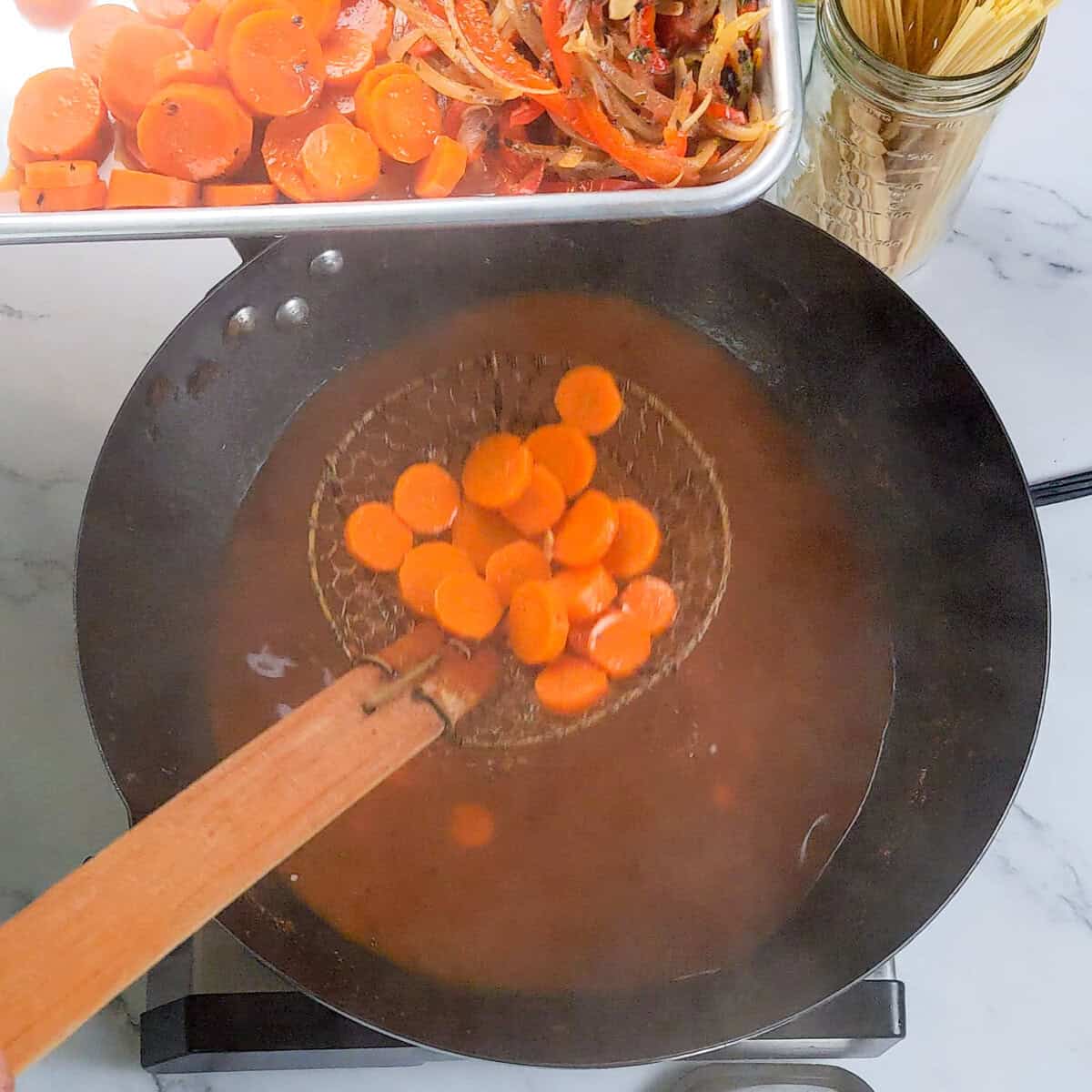
Cooking the vegetables separately helps with assembling later.
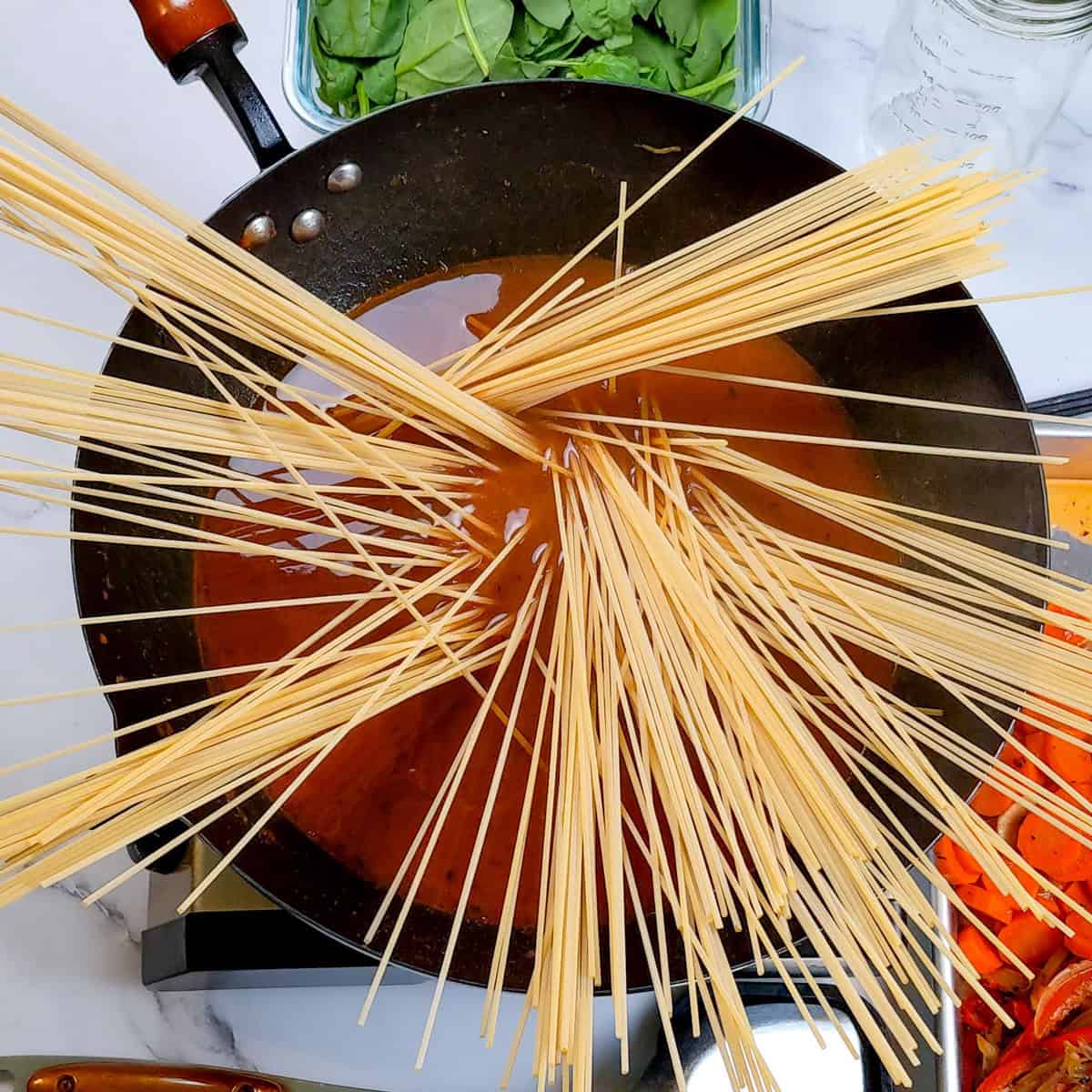
Next, add your noodles and simmer until al dente, about 8-10 minutes. In the final 2-3 minutes,

Using a large pot of water to cook pasta isn't always necessary-especially when you're cooking it in a smaller amount of water or broth-but be sure to stir frequently to prevent sticking and avoid overcrowding the pot; just don't forget to keep an eye on the liquid level to ensure the pasta stays submerged and cooks evenly.
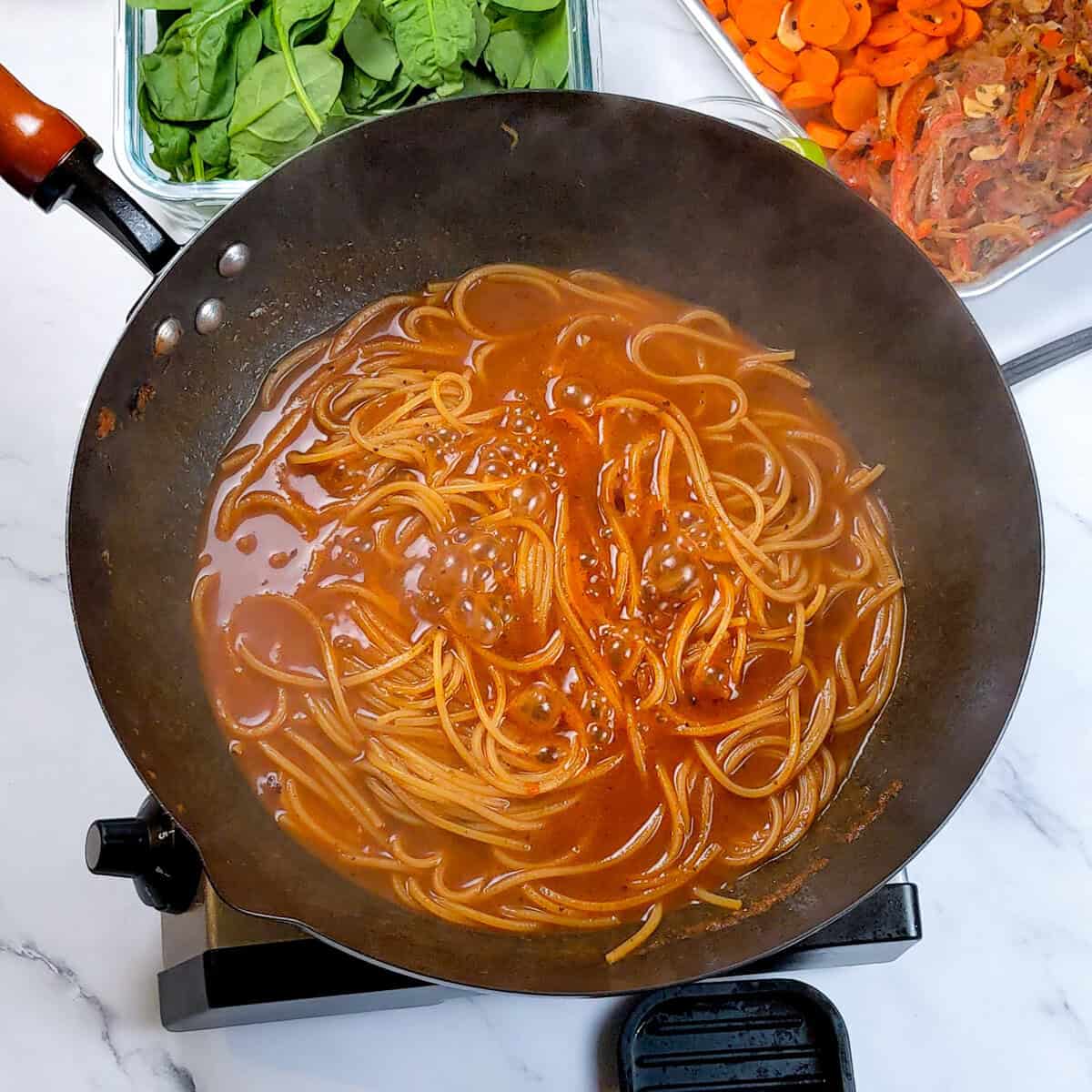
Cooking the pasta in the broth adds flavor to the pasta while thickening the sauce simultaneously.
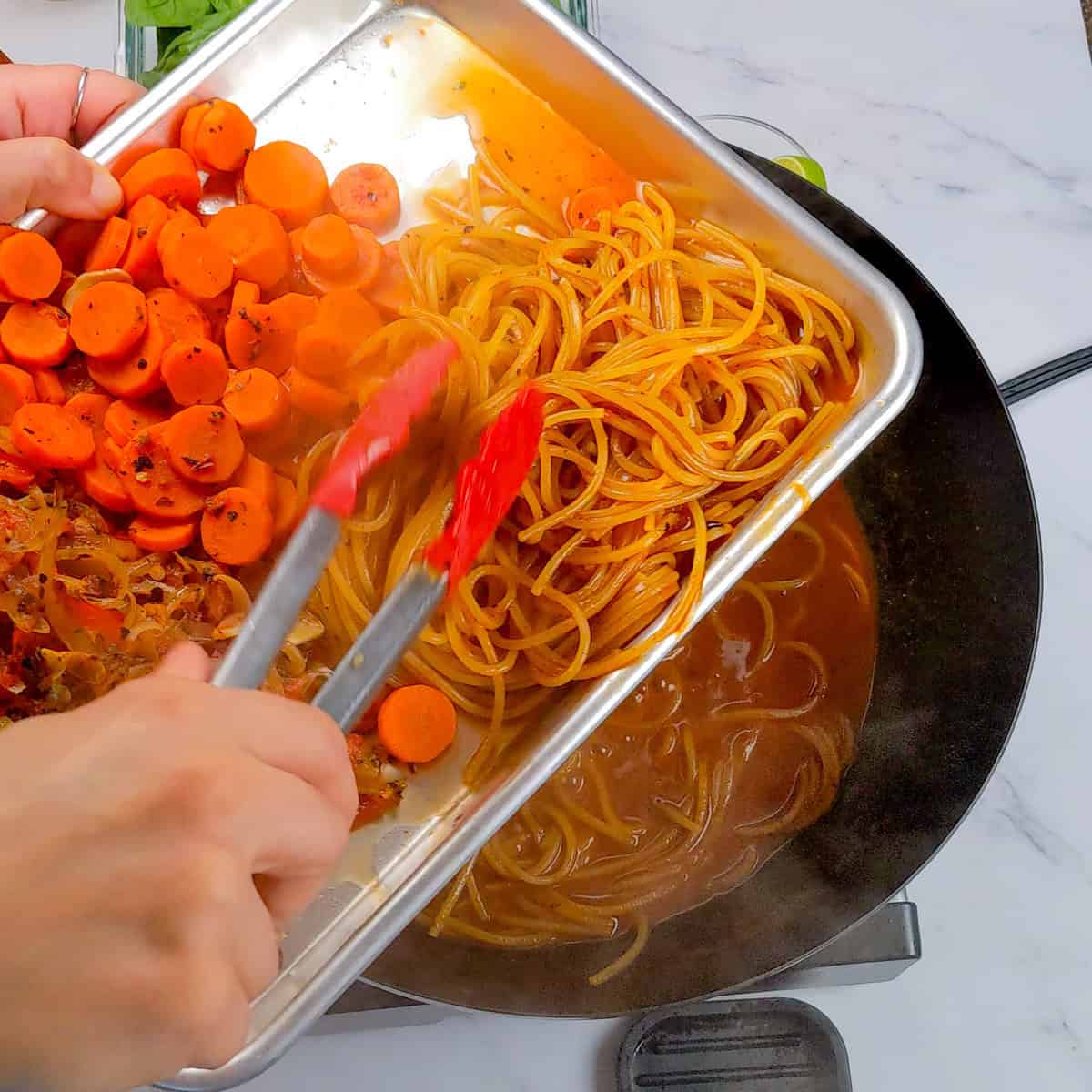
Spread all ingredients on the sheet pan to prevent overcooking.
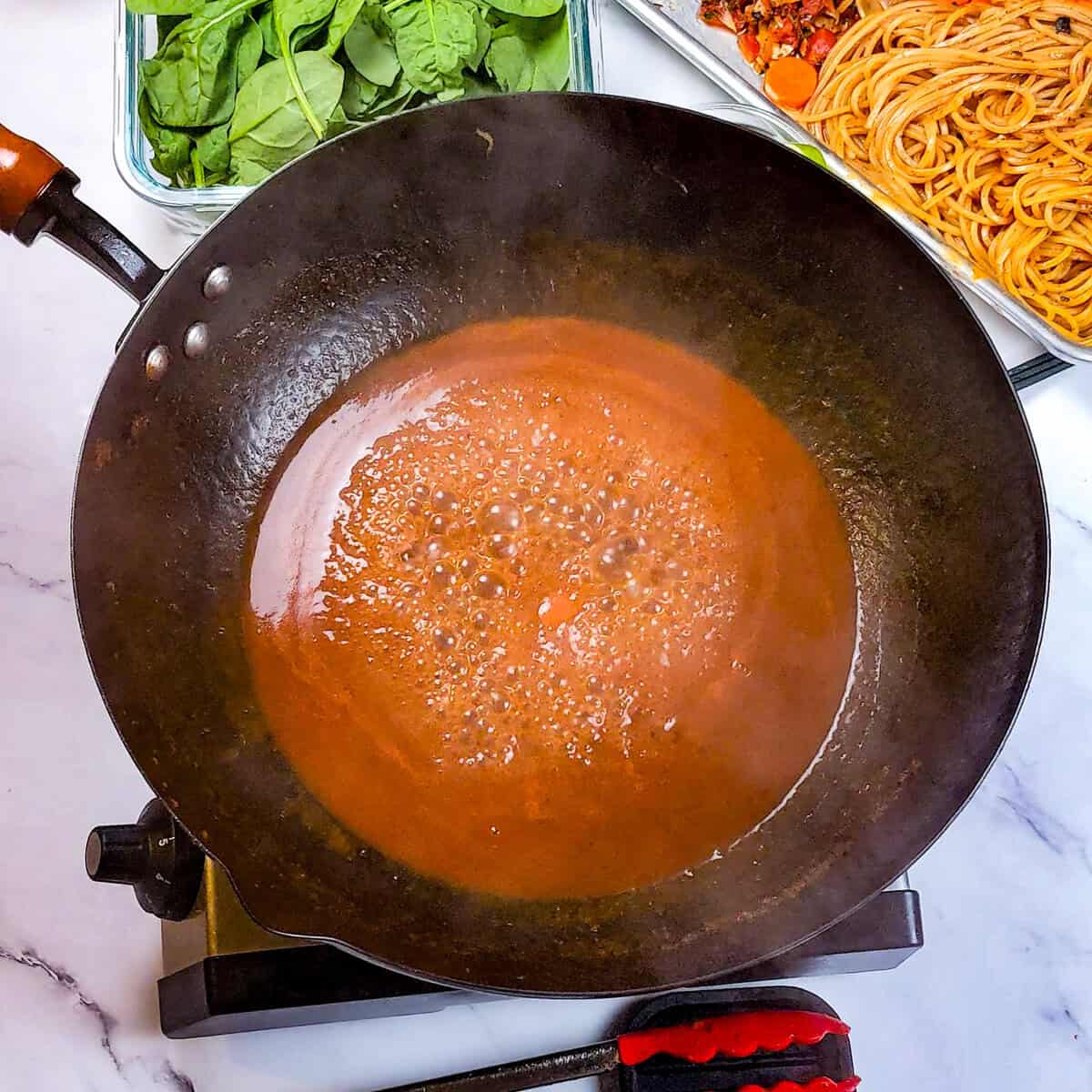
Fat will cling to the spinach; adding it to a clear broth has its advantage when it comes to this.
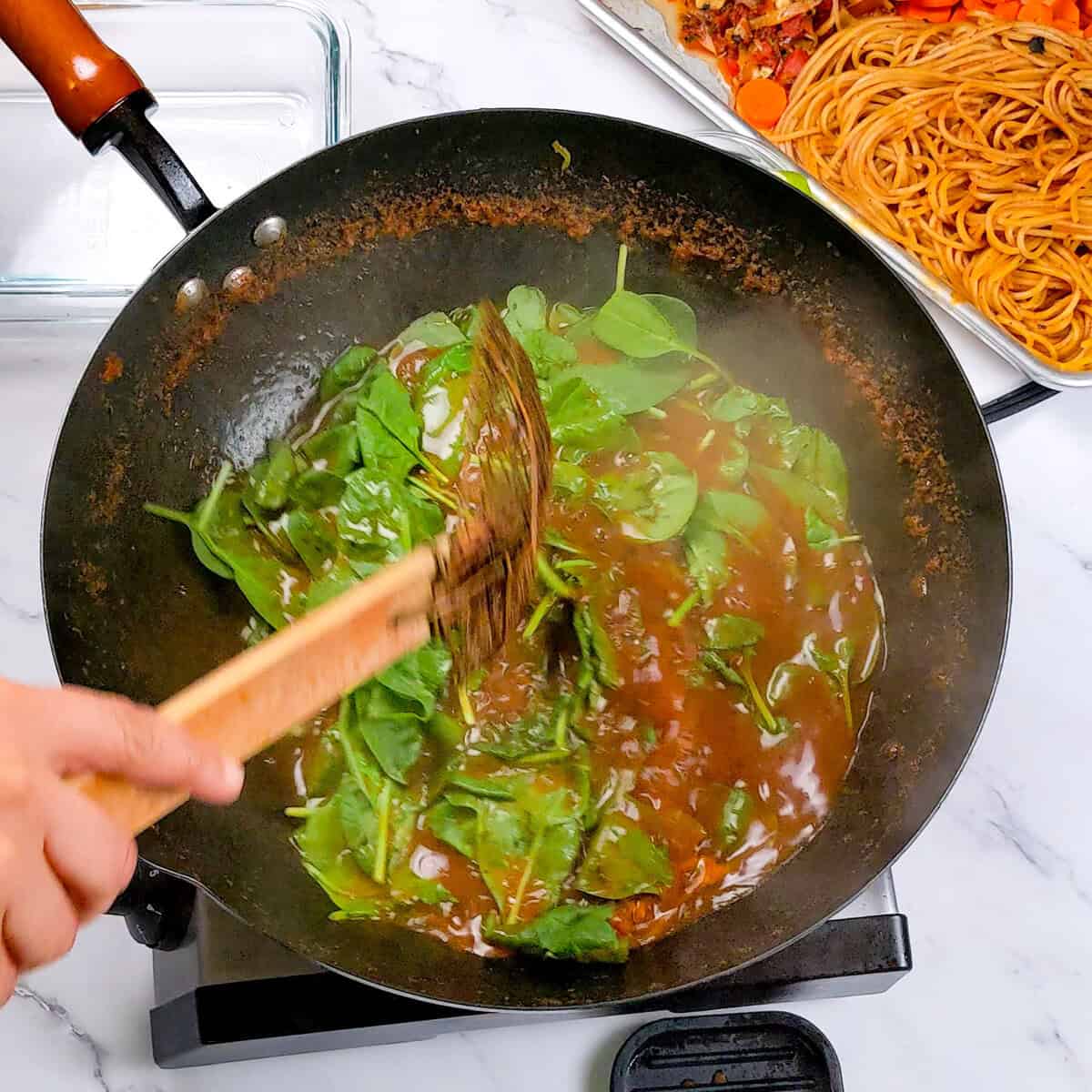
Stir in the spinach and let it wilt before removing from the broth.
To Assemble
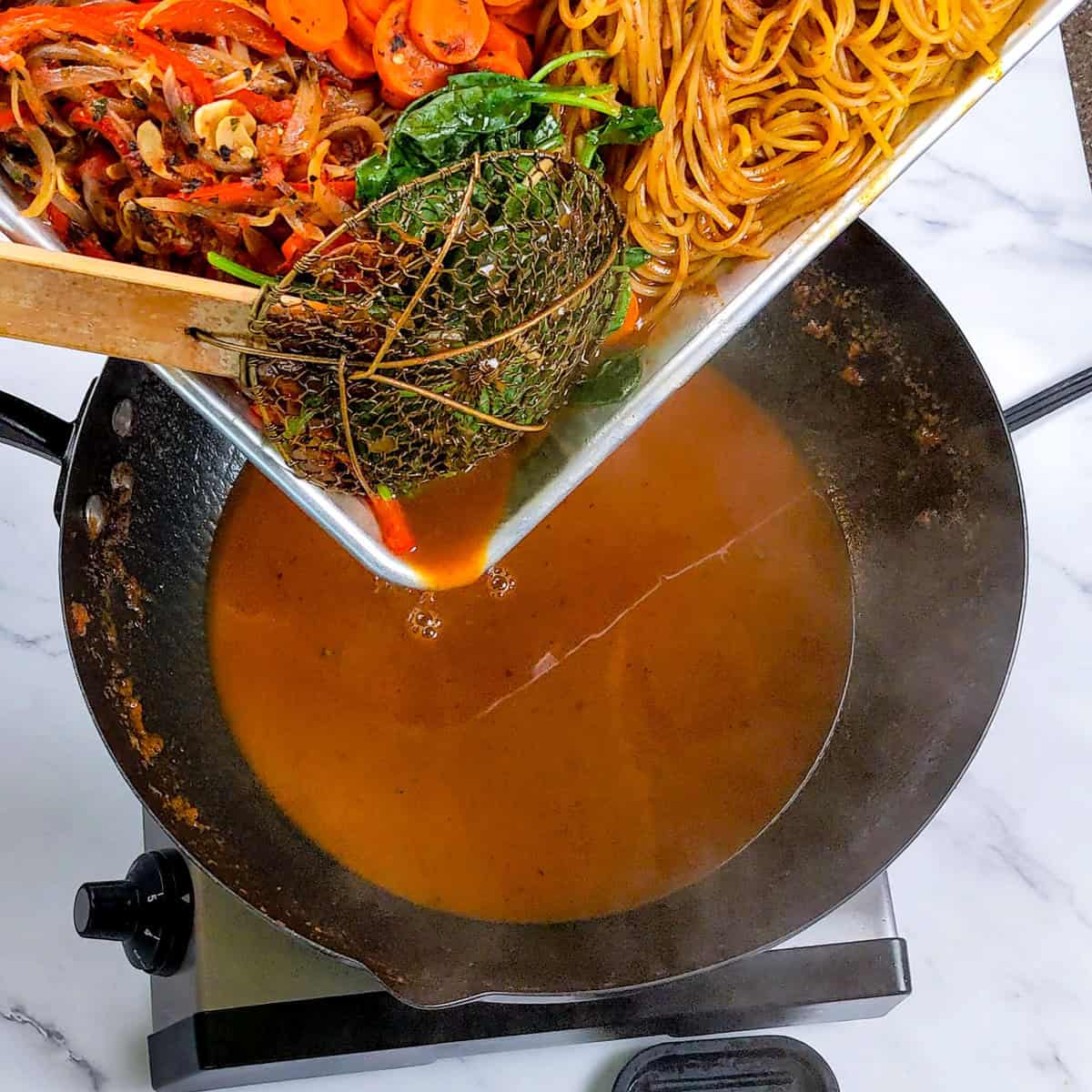
Add the excess broth back to the wok.
-
5.0
$29.99$28.49My Review: The BIELMEIER 12.5" Carbon Steel Wok is hands down my favorite wok to cook with. The size is perfect, not too big, not too small, and the flat bottom makes it super easy to use on any stovetop, especially for stir-fries and high-heat cooking. I was also impressed by the thoughtful design and the sleek packaging, which honestly makes it a great gift for anyone who loves to cook. What really stood out was the thorough set of instructions included on how to season and care for the wok, perfect for novice wok users who might feel intimidated. It’s a beautiful, functional piece that’s earned its permanent spot in my kitchen. Read my article on how to use a wok here.
Buy on AmazonPurchased: July 12, 2022We earn a commission if you make a purchase, at no additional cost to you.
12/30/2025 11:01 am GMT -
Buy on Amazon$16.95
We earn a commission if you make a purchase, at no additional cost to you.
12/30/2025 02:05 am GMT -
Buy on Amazon$16.95
We earn a commission if you make a purchase, at no additional cost to you.
12/30/2025 03:01 pm GMT -
Buy on Amazon$8.99
We earn a commission if you make a purchase, at no additional cost to you.
12/30/2025 02:05 pm GMT -
Buy on Amazon$11.99
We earn a commission if you make a purchase, at no additional cost to you.
12/30/2025 02:06 pm GMT -
Buy on Amazon$29.99
We earn a commission if you make a purchase, at no additional cost to you.
12/30/2025 03:01 pm GMT -
Buy on Amazon$37.99
We earn a commission if you make a purchase, at no additional cost to you.
12/30/2025 06:01 am GMT -
Buy on Amazon$32.99
We earn a commission if you make a purchase, at no additional cost to you.
12/30/2025 05:02 pm GMT -
4.8
$43.99$32.99My Review: This knife is well-made. Super solid and multi-functional. It is made with high-carbon steel, so it will not rust. Slicing meat like fish is easier with the grooves. It doesn’t stick to the knife. The handle has an excellent grip, and it's not heavy. For some background, a Santoku is a versatile Japanese kitchen knife characterized by its straight edge and "sheepsfoot" blade, designed for precise slicing, dicing, and chopping. Its name means "three virtues," referring to its ability to handle meat, fish, and vegetables efficiently, making it a staple in both professional and home kitchens.
Buy on AmazonPurchased: 08/19/24We earn a commission if you make a purchase, at no additional cost to you.
12/30/2025 02:02 pm GMT -
Buy on Amazon$12.99
We earn a commission if you make a purchase, at no additional cost to you.
12/30/2025 02:06 pm GMT
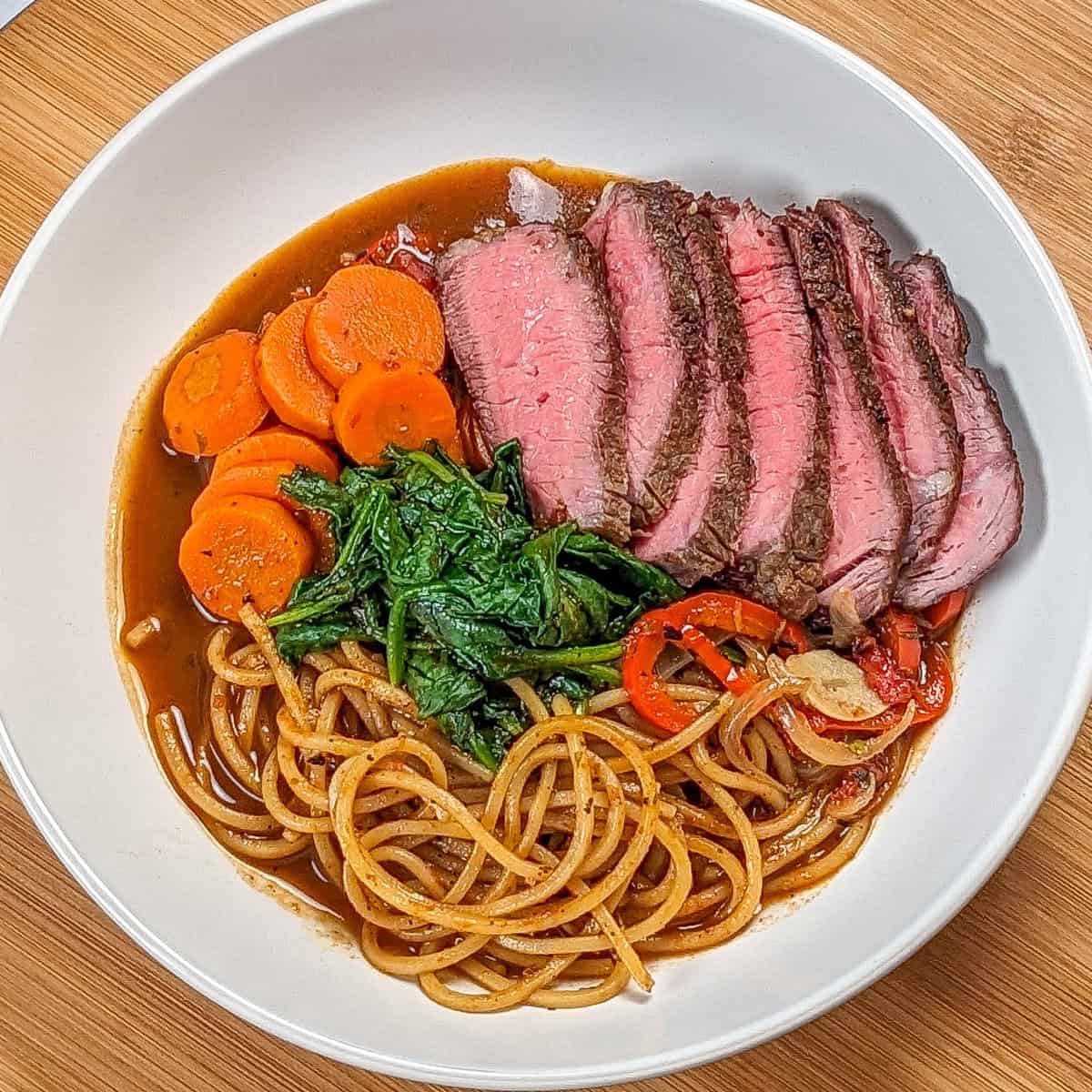
Ladle the spicy beef broth and noodles into bowls, adding a generous amount of carrots and spinach. Top each bowl with a few slices of steak, and finish with fresh parsley and lime wedges for garnish.
To determine the best slice thickness for your steak, aim for thin slices-about ¼ inch thick-since they're easier to eat in the soup, absorb more of the flavorful broth, and create tender bites in every spoonful, which is how I prefer it for maximum flavor and texture.
Substitutions
Dairy Free
- Yay! This recipe is already dairy-free.
Gluten-Free
- Spaghetti - Substitute the spaghetti with gluten-free spaghetti or rice noodles.
Vegetarian
- Beef Bone Broth - Simply swap the beef broth for a low-sodium vegetable broth.
- Steak - Replace the steak with a mix of mushrooms like white button, cremini, oyster, and shiitake. These mushrooms bring a savory, umami flavor that mimics the richness of beef, making the soup equally satisfying and flavorful.
Convenience
- Scotch Bonnet Pepper - Jalapeño or Serrano Pepper (if you want less heat).
- Fire-Roasted Tomatoes - Canned Diced Tomatoes with a pinch of smoked paprika for a smoky flavor.
- Beef Bone Broth - Store-bought beef or chicken stock or vegetable broth.
- Fresh Thyme - Dried thyme (use about one-third the amount of fresh).
- Fresh Parsley - Dried parsley, fresh cilantro, or omit if unavailable.
- Ground Clove - Ground allspice (though milder, it offers a similar warmth).
- Spaghetti - Any other pasta like linguine or fettuccine.
- Sliced Garlic Cloves - Try granulated or garlic powder.
Change Heat Level - Modify the delicious beef noodle soup recipe's heat level to your liking and learn more about the Scoville Scale and Chili Pairings.
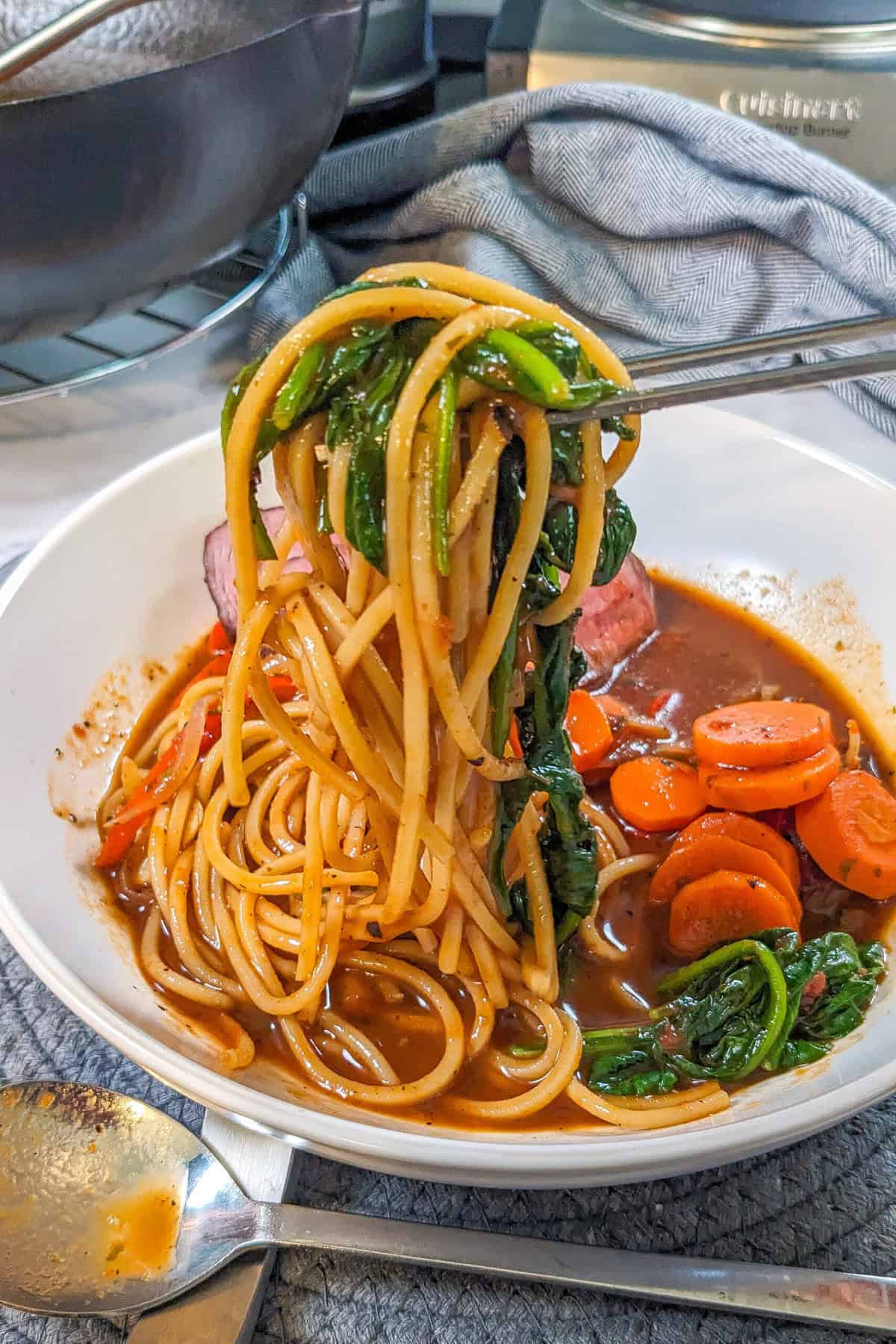
Variations
Explore and experiment by getting creative and making it your own, and don't forget to share the outcome.
- Bay Leaves - Add a bay leaf to the delicious broth as it simmers to deepen the flavor and bring a subtle earthiness to the soup.
- Different Cuts of Beef - Try using beef shank, short ribs, or beef stew meat for extra richness, and use an Instant Pot to reduce cooking time or a slow cooker if you want to prep the soup while focusing on other tasks.
- Leafy Greens - Swap spinach for leafy greens like bok choy, which adds a mild, slightly sweet crunch to balance the bold flavors.
- Crunchy Garnishes - For added texture, garnish the soup with sliced green onions to give a fresh, crunchy finish.
- Fresh Noodles - Get creative by using fresh, wide egg noodles for a heartier and more indulgent twist, bringing an extra layer of comfort to the dish.
- Fresh Ginger - Add fresh ginger alongside the garlic and clove to enhance the broth's complexity, giving a warm, spicy undertone that complements the heat of the scotch bonnet pepper.
- Fresh Herbs - Sprinkle fresh cilantro over the finished soup to brighten the flavors and add a fragrant, herbal note that pairs beautifully with the bold, spicy broth.
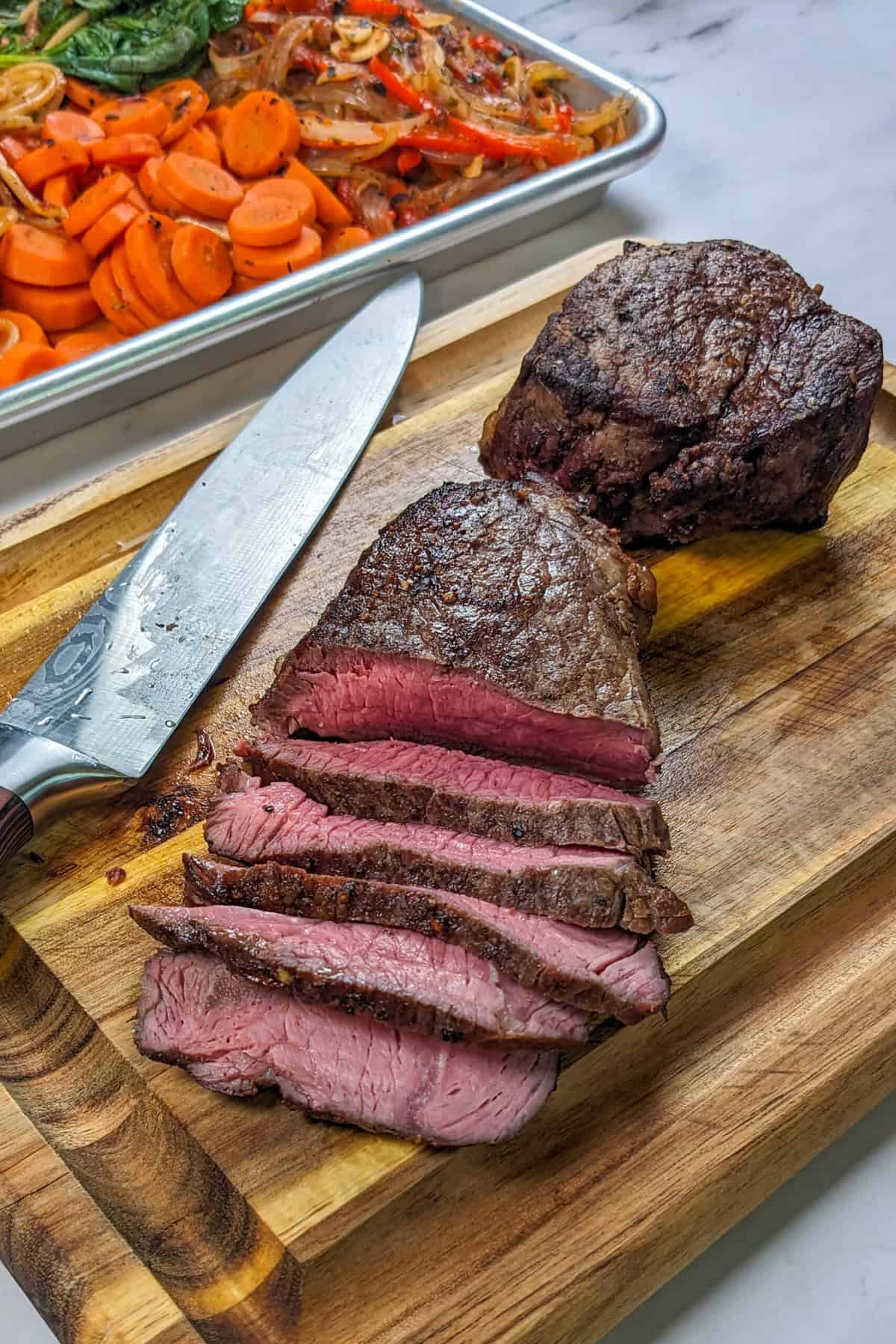
Equipment
Cookware
- Wok or Large Dutch Oven - You'll use the wok (or Dutch oven) to sear the steak and prepare the broth. A wok heats quickly and evenly, perfect for sautéing ingredients, while a Dutch oven provides the added benefit of being oven-safe, making it ideal for finishing thicker cuts of steak without transferring it to a sheet pan.
- Sheet Pan (for Cooked Vegetables) - Once the vegetables are cooked, transfer them onto a sheet pan to keep them warm while you finish assembling the dish. The flat surface allows them to cool evenly without becoming mushy.
Accessories
- Tongs - Use tongs to handle the steak when searing, turning, and transferring it from the wok to the oven. They provide a firm grip and allow you to flip the steak without piercing it, preserving the juices.
- Sharp Carving Knife - A sharp carving knife is crucial for slicing the rested steak into thin, even slices, which makes for a beautiful presentation and perfect bite-sized pieces in your soup. Don't have a carving knife? Don't worry; just use any common sharp knife.
- Liquid Measuring Cup - You'll need this to measure out broth, water, or any other liquids accurately. Precise measurements help maintain the balance of flavors in the soup.
- Meat Thermometer - Essential for checking the internal temperature of your steak, the meat thermometer ensures you cook the steak to your preferred doneness (medium-rare or medium), taking the guesswork out of the process.
- Wok Lid - Use the lid to cover the wok while the broth simmers, trapping in heat and moisture to ensure that the ingredients cook evenly and the flavors meld together perfectly.
Optional Tools
- Sheet Pan with Rack (Optional) - For thicker steak cuts, a sheet pan with a rack allows you to transfer the steak from the wok to the oven. The rack elevates the steak, ensuring even cooking and air circulation for a perfectly cooked interior.
- Wok Spatula (Optional) - The wok spatula tool is ideal for stir-frying and sautéing ingredients in the wok, as its shape helps you easily toss and turn vegetables and meat, ensuring even cooking without damaging delicate ingredients.
- Wok Spider (Optional) - The wok spider tool helps you easily remove ingredients like noodles or vegetables from the broth without bringing excess liquid with them. Its wide surface makes it great for lifting out delicate ingredients while keeping the broth intact. The other choice would be to use a strainer with a container to reserve the liquid to place back into the pot.
- Skimmer (Optional) - A skimmer is used to remove any oil foam or impurities from the surface of the broth, ensuring you have a clear, clean broth for your soup. This step is important for both presentation and taste. You can also just use a spoon or skip this step.
Kitchen Must Haves - Find other tools I use here.
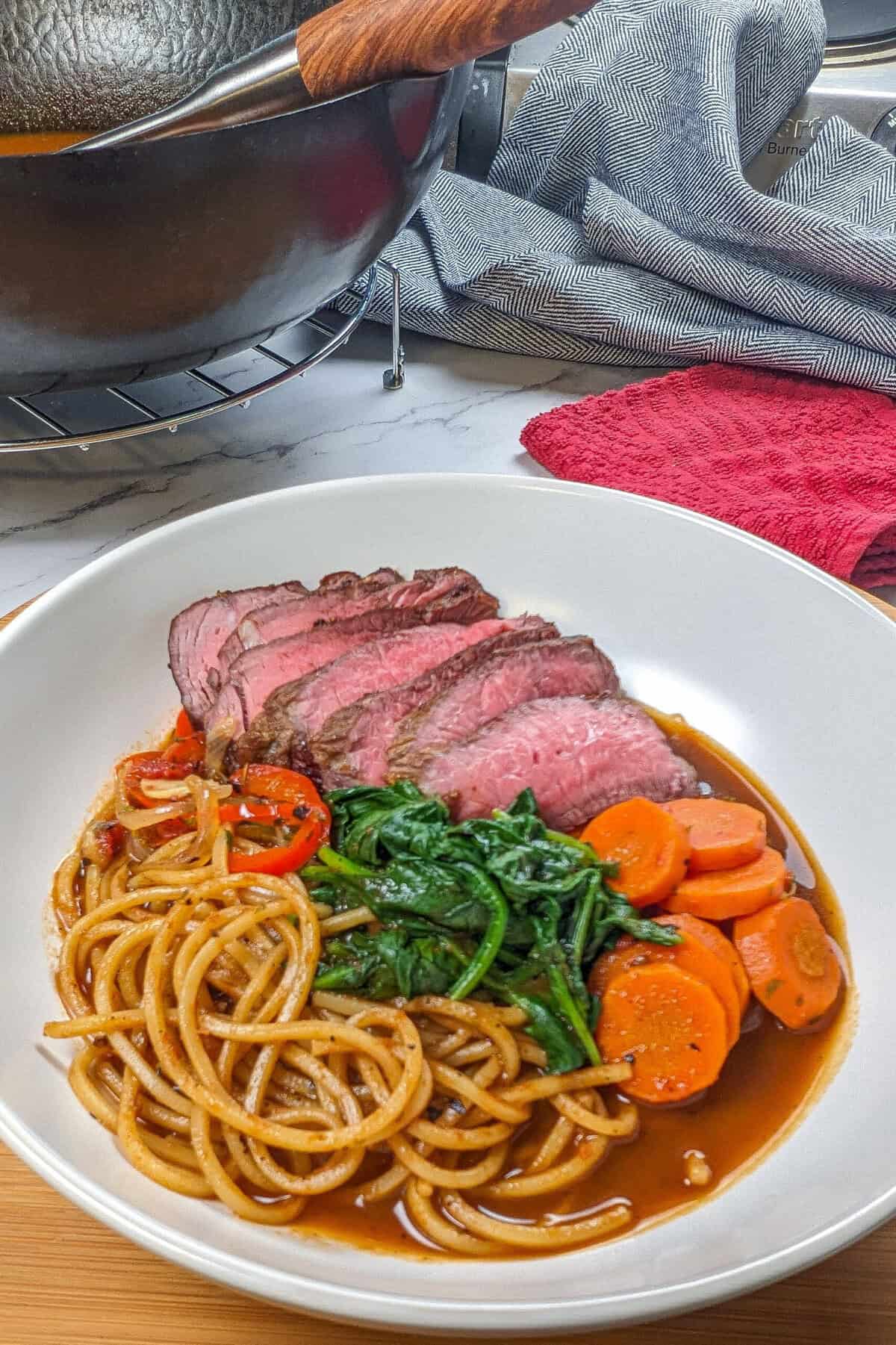
Storage and Reheating
- Refrigerator - Store the leftover soup (i.e., cooked pasta, steak, and vegetables) separately in an airtight container in the fridge for up to 3 days. Keep the ramen broth for up to 4 days in a sealed container.
- Freezer - Freeze the cooked pasta in a freezer-safe bag (laid flat) for up to 1 month. For the cooked steak and vegetables, freeze them separately in a freezer-safe container for up to 2 months. Also, ramen broth can be frozen into portions for up to 3 months.
- Reheating - If frozen, thaw the ingredients first. Then, optionally reheat the pasta by quickly dipping it into boiling water for 1-2 minutes or reheating everything gently in a skillet over medium heat or in the microwave for 1-2 minutes in short bursts to avoid overcooking and retain moisture.
Airtight Food Containers - I interchange glass food storage containers with plastic clipping lids or wooden push-ins. I always suggest glass storage containers because they can be microwaved, they hold food without staining, and the glass keeps the food at a more stable temperature, keeping it fresher and longer.
Try the OXO Good Grips Smart Seal Glass Rectangle Food Storage Containers or the Pyrex Freshlock Glass Food Storage Containers.
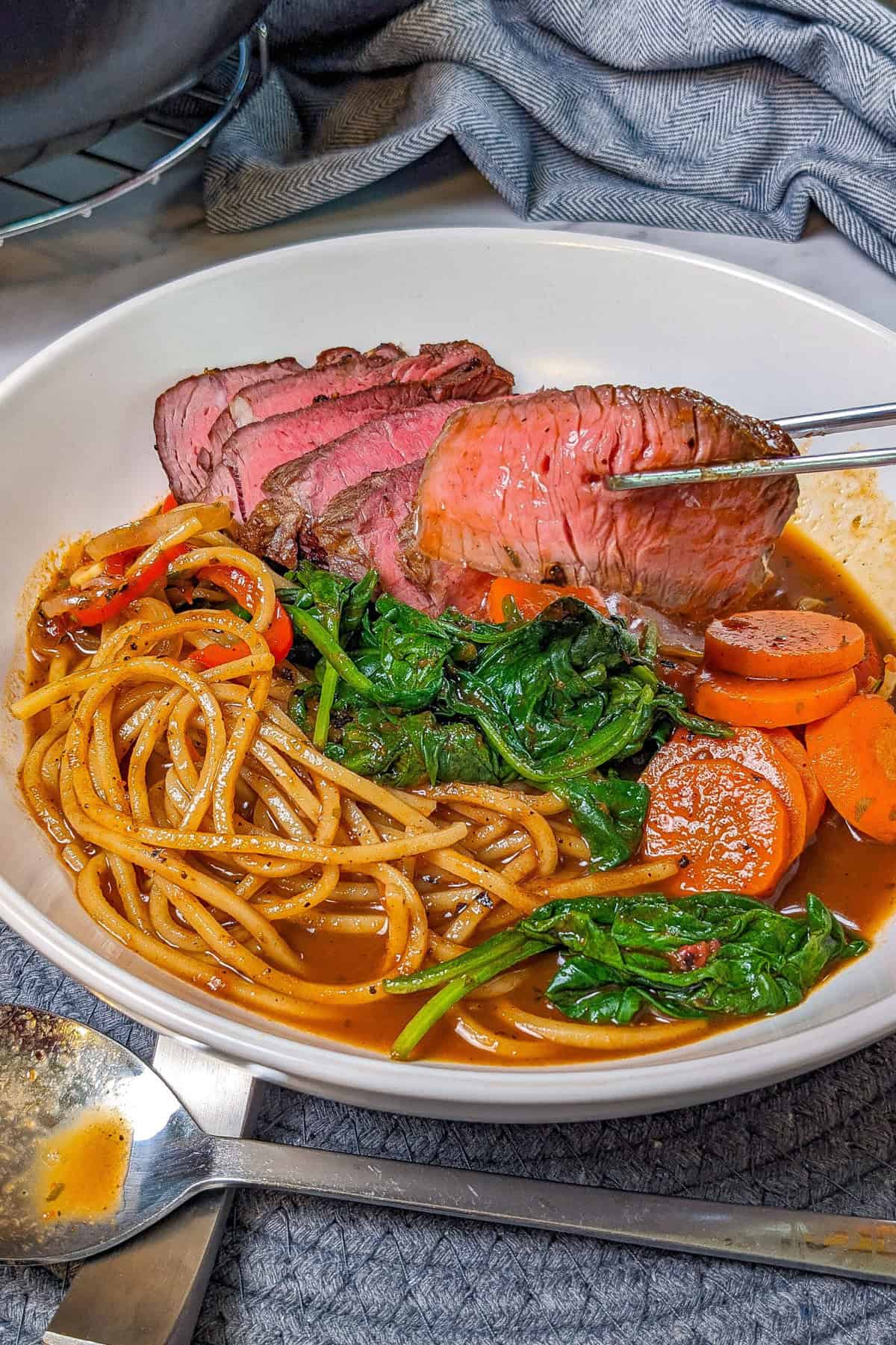
Cooking Tips
- Choosing the Right Steak Cut - Sirloin is a great balance between tenderness and flavor, but ribeye works well too!
- Adjusting Spice Levels - If you're sensitive to heat, reduce the amount of scotch bonnet or substitute with a milder pepper.
- Ingredient Substitutions - Feel free to use ramen or egg noodles instead of spaghetti, and if you don't have beef bone broth, regular beef stock works in a pinch.
- Overcooking the Steak - Keep an eye on the internal temperature using a meat thermometer, especially when finishing in the oven.
- Not Prepping Ingredients - Rushing through the cooking process without prepping ingredients ahead can lead to stress and mistakes.
- Overcooking the Spinach - Add spinach toward the end to avoid it becoming mushy. Wilted spinach is perfect for this dish.
Your Cooking Tips Resource Guide - Become a better home cook with tips to help you cook more efficiently on the Cook's Notebook tab.
Frequently Asked Questions
To dial down the heat, reduce or omit the scotch bonnet pepper, and consider using a milder pepper like jalapeño or none at all. You can always add a bit of spice at the end with hot sauce if needed.
If you don't have spaghetti, you can substitute it with any other long pasta like fettuccine or linguine, or try rice noodles or even gluten-free pasta if you're avoiding gluten.
Yes! This recipe works well with beef shank, short ribs, or stew meat. Just note that tougher cuts may require longer cooking times, so using an Instant Pot or slow cooker is a great alternative for these.
Definitely! You can make the broth and cook the vegetables ahead of time, then store them separately. Reheat the broth and add freshly cooked noodles and steak just before serving for the best texture.
To make it vegetarian, swap the beef broth for vegetable broth and replace the steak with a mix of mushrooms like white button, cremini, oyster, and shiitake to add a savory, umami flavor.
Beef, Lamb, and Pork Recipes
Looking for other recipes like this? Try these:
- Pan-Roasted Chicken and Andouille Sausage Gumbo
- Steak Shawarma Recipe with Fall Holiday Flavors | Easy Lebanese Style
- Ultimate Loaded Nachos Recipe | Cheese Sauce & Pepper Crema
- Jerk Fajita Trio: 3 Must-Try Recipes for a Spicy Weeknight Cook-Up
Soups and Stews Recipes
Looking for other recipes like this? Try these:
- Creamy Chicken Corn Chowder with Dumplings | Dairy-Free
- One-Pot Curry Meatball Soup with Ground Turkey and Kale
- How to Make Easy Bacon Potato Leek Chowder | Creamy Comfort
- Instant Pot Spicy Beef Barley Stew: Haitian Hearty Comfort
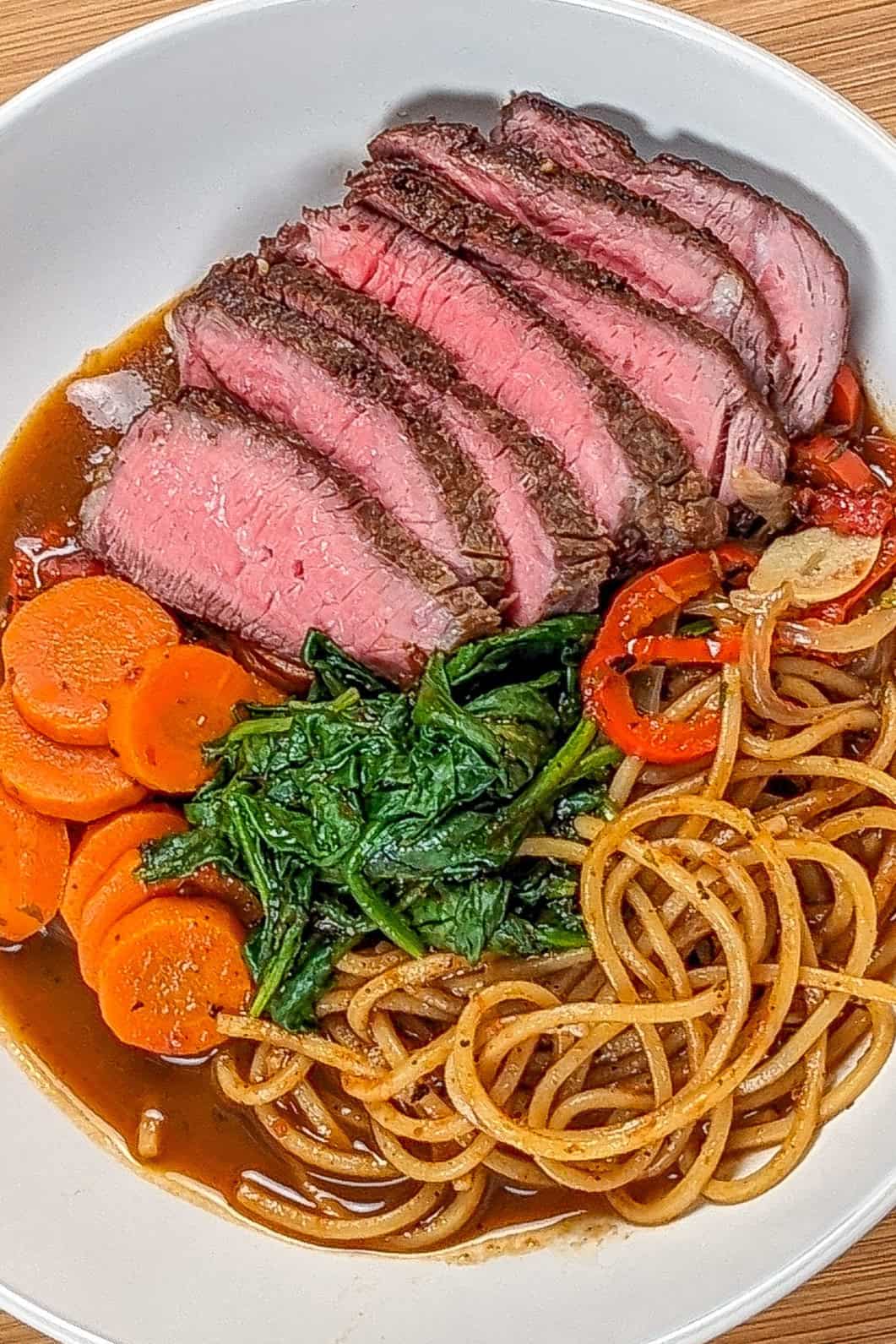
📖 Recipe
Bold and Spicy Caribbean Beef Noodle Soup Recipe Twist
Ingredients
For the Steak
- 12 ounces sirloin steak
- Salt and pepper
For the Aromatic Base
- 1 tablespoon olive oil
- 1 medium onion thinly sliced
- 1 medium red bell pepper thinly sliced
- 4 cloves garlic thinly sliced
- 1 scotch bonnet pepper thinly sliced (Use half for less heat)
For the Broth
- 1 cup crushed fire-roasted tomatoes
- ½ teaspoon dried thyme
- Pinch of ground clove
- 5 sprigs Fresh parsley chopped
- 4 cups beef bone broth
- Salt and pepper to taste
For the Vegetables and Noodles
- 2 large carrots sliced thick
- 8 ounce spaghetti pasta or other noodles
- 2 cups packed spinach
For Garnish
- Fresh parsley
- 1 Lime for wedges
Equipment
Instructions
- Save time in the kitchen: Read the instructions thoroughly, then gather and prep all your ingredients before cooking! Learn Prepping Tips.
- Importance of Steak Size: Finish your steak cut in the oven if it is over 1.5 inches. To do this, preheat your oven to 375°F (190°C).
- Sear the Steak: Heat the wok first, then add 1 tablespoon olive oil over medium-high heat. Season the steak with salt and pepper on both sides. Then, sear the steak for 3-4 minutes on each side until medium-rare (or your preferred doneness). Remove the steak from the wok and set it aside to rest.
- Transfer Steak to the Oven: For thicker steak cuts, after searing, transfer the steak to an oven-safe dish or a baking sheet. If your wok is oven-safe, you can place it directly in the oven. Use a meat thermometer to ensure precise cooking. Place the thermometer in the thickest part of the steak.
- For Medium-Rare: Cook until the internal temperature reaches 125-130°F (52-54°C). For medium: Cook until the internal temperature reaches 135-140°F (57-60°C). The timing will vary depending on the thickness of your steak, but generally, this should take 5-10 minutes for a 1.5 to 2-inch thick steak.
- Prepare the Spicy Beef Broth: In the same wok, add a little more olive oil if needed. Add and combine the onions, green bell pepper, garlic, and scotch bonnet pepper and cover to steam for 4-5 minutes on medium heat until softened and fragrant.
- Next, uncover and stir to brown for 1-2 minutes. Stir in the fire-roasted tomatoes, thyme, ground clove, and fresh parsley. Then, cook for 4-5 minutes to allow the ingredients to meld. Pour in the beef bone broth, bring to a boil on high heat, and season with salt and pepper to taste.
- Cook Vegetables and Noodles: Remove the bell pepper mixture with a strainer and set aside on a tray. Then, add the thick-sliced carrots to the broth and cook for 5-6 minutes, or once the carrots are slightly tender, remove and set aside.
- Next, add the spaghetti noodles and simmer until the pasta is cooked al dente, about 8-10 minutes. Add more water if necessary to cover the noodles. In the final 2-3 minutes of cooking, stir in the spinach and let it wilt. Then, remove it and set it aside.
- Slice the Steak: Thinly slice the rested steak and set aside for serving. Next, assemble and serve. Ladle the ramen broth and noodles into bowls, ensuring a generous amount of carrots and spinach is in each bowl. Then, top each bowl with a few slices of steak. Finally, garnish with fresh parsley and serve with lime wedges on the side.
Nutrition
Subscribe to the YouTube Channel
SUBSCRIBE: 👈To my YouTube Channel to Get Notifications of New Videos.
Have a Comment or Question?
If you have a question or comment about this Caribbean beef noodle soup recipe, please post it below. You will definitely get a quick response. It also helps our other readers to stay informed. Thanks!


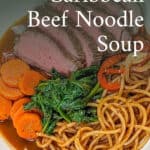
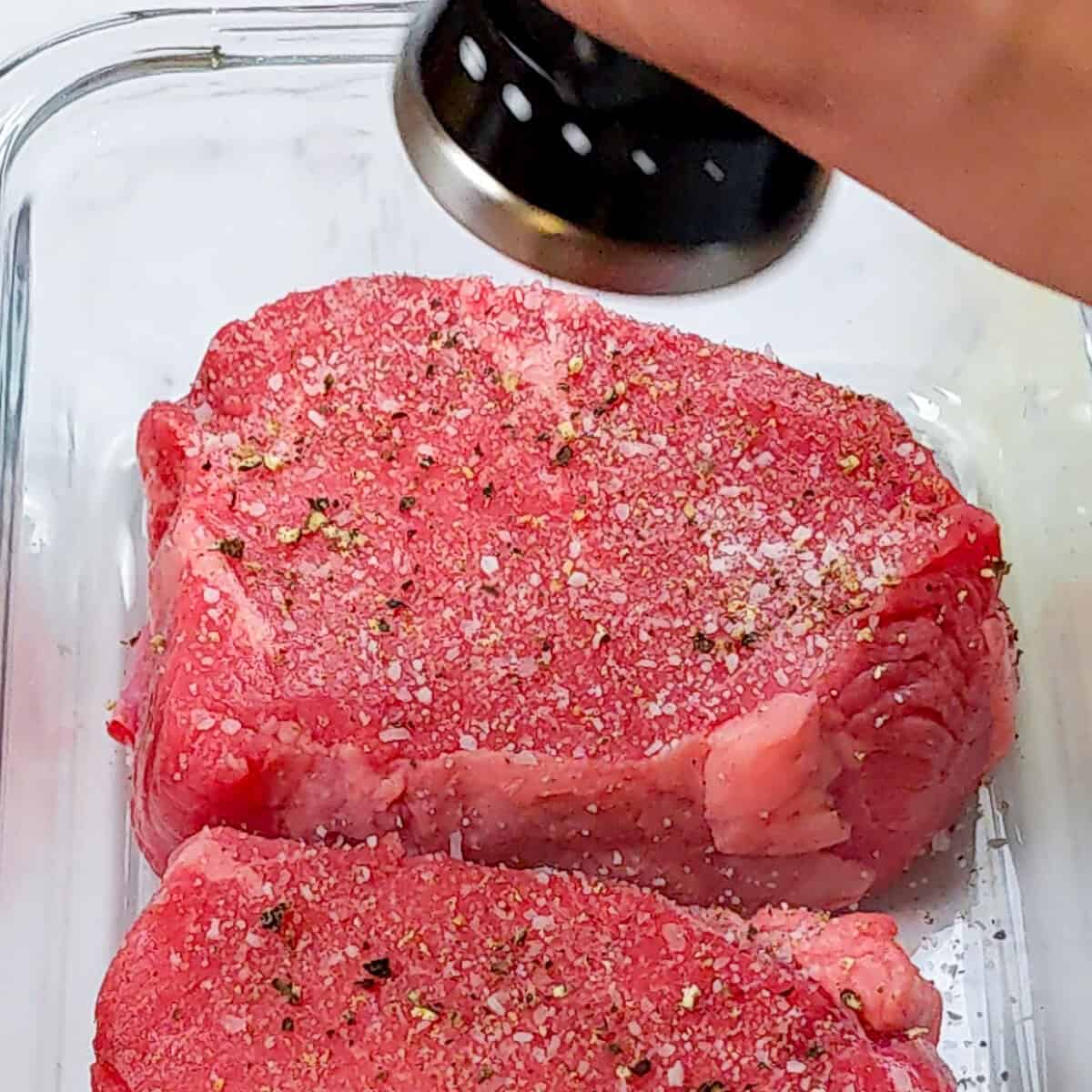
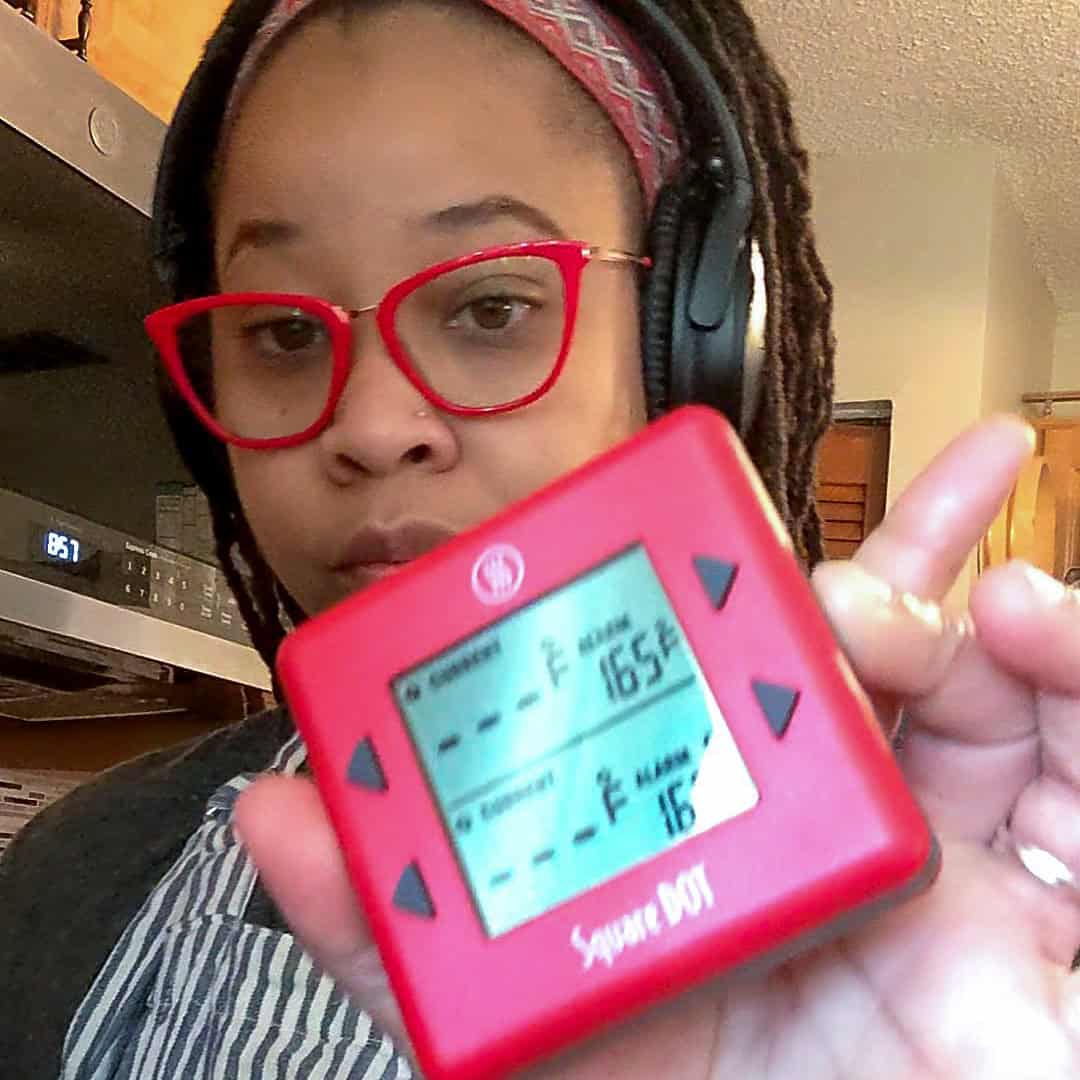
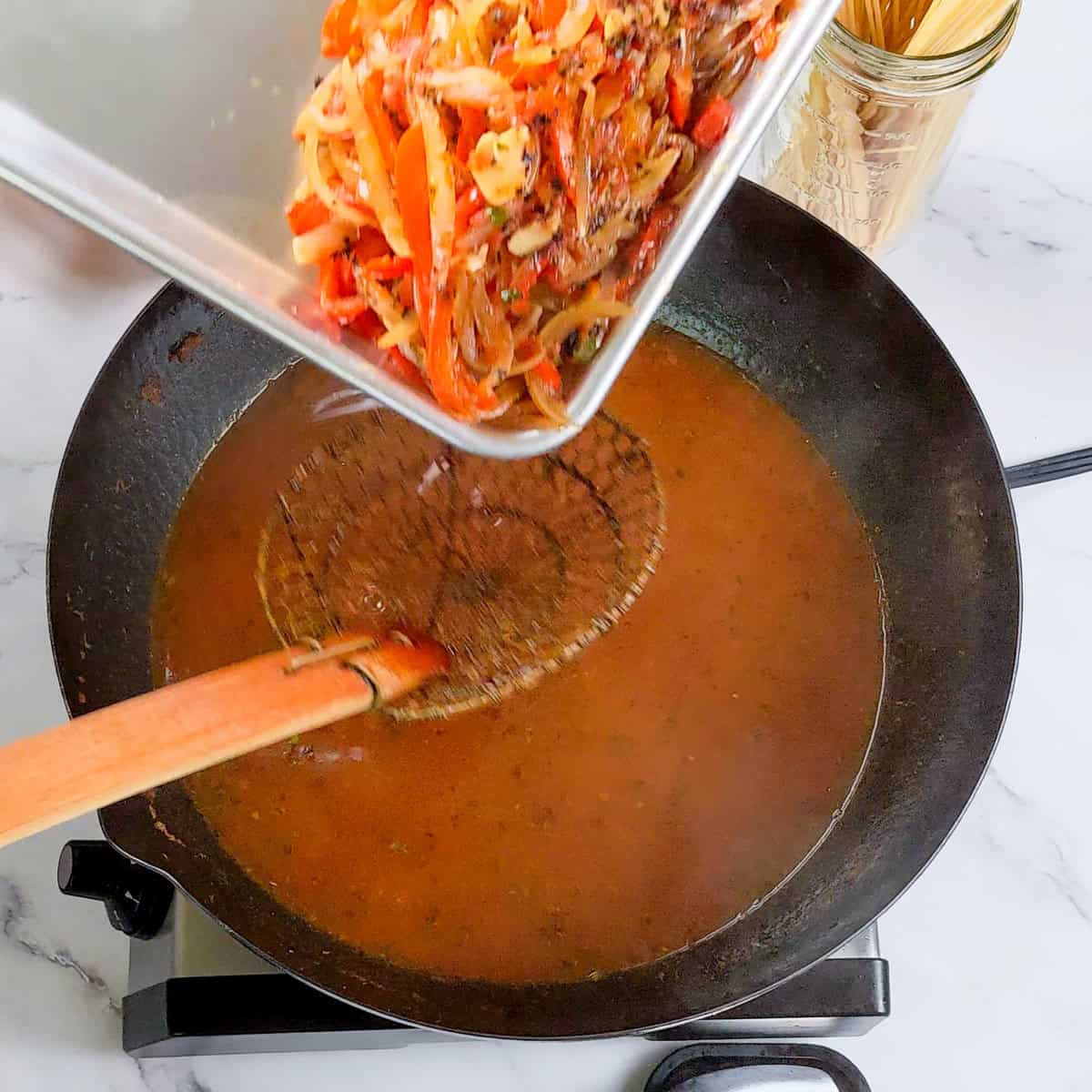
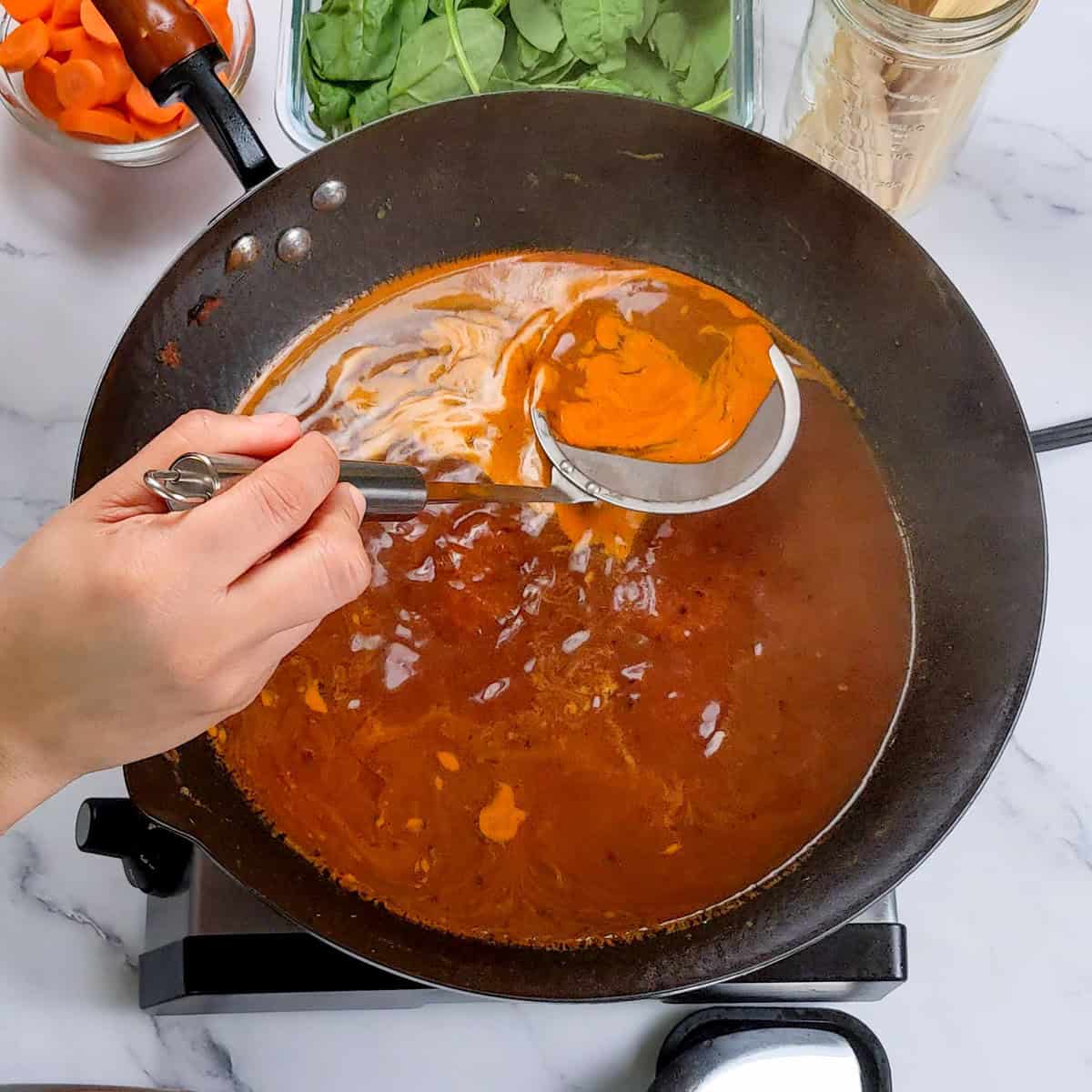
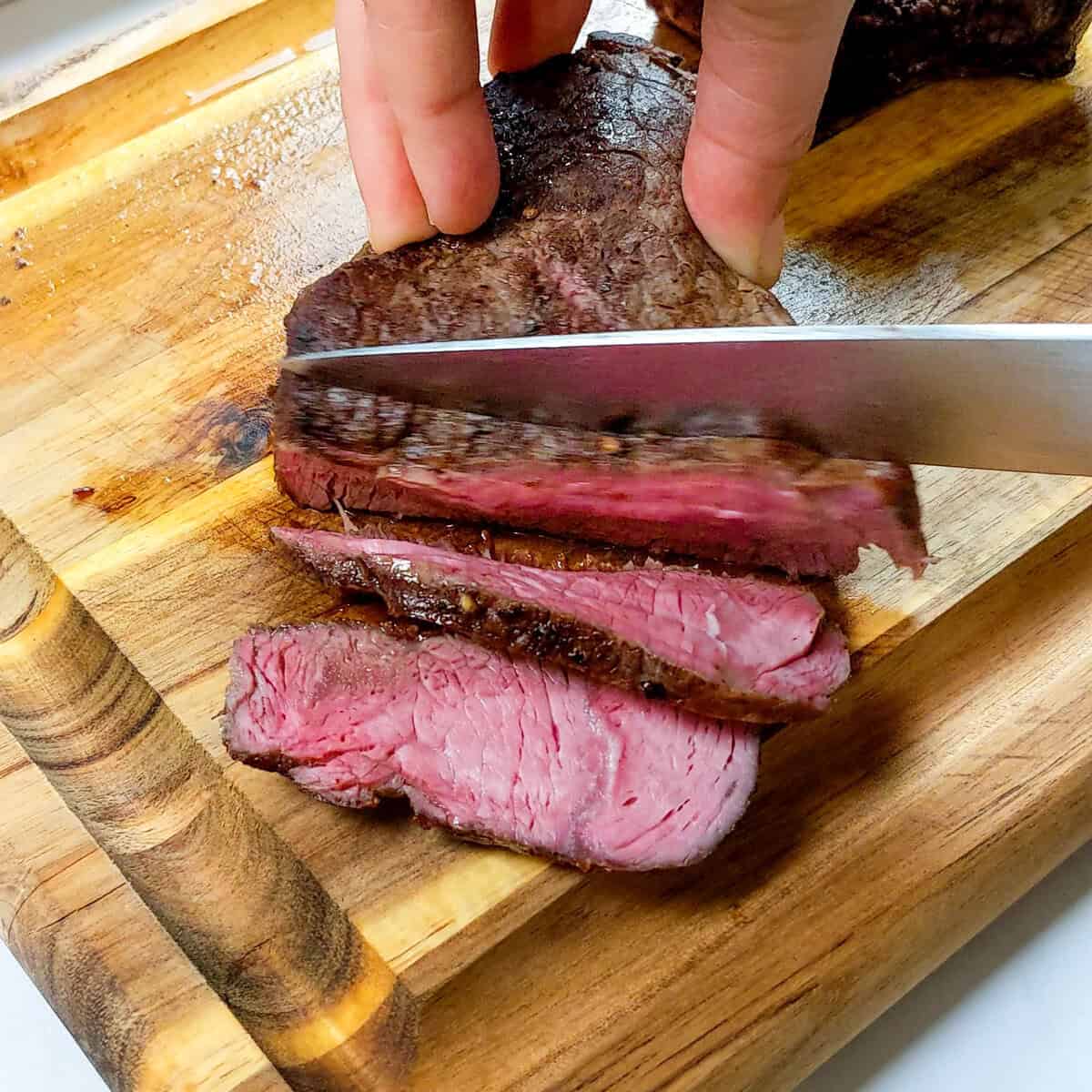
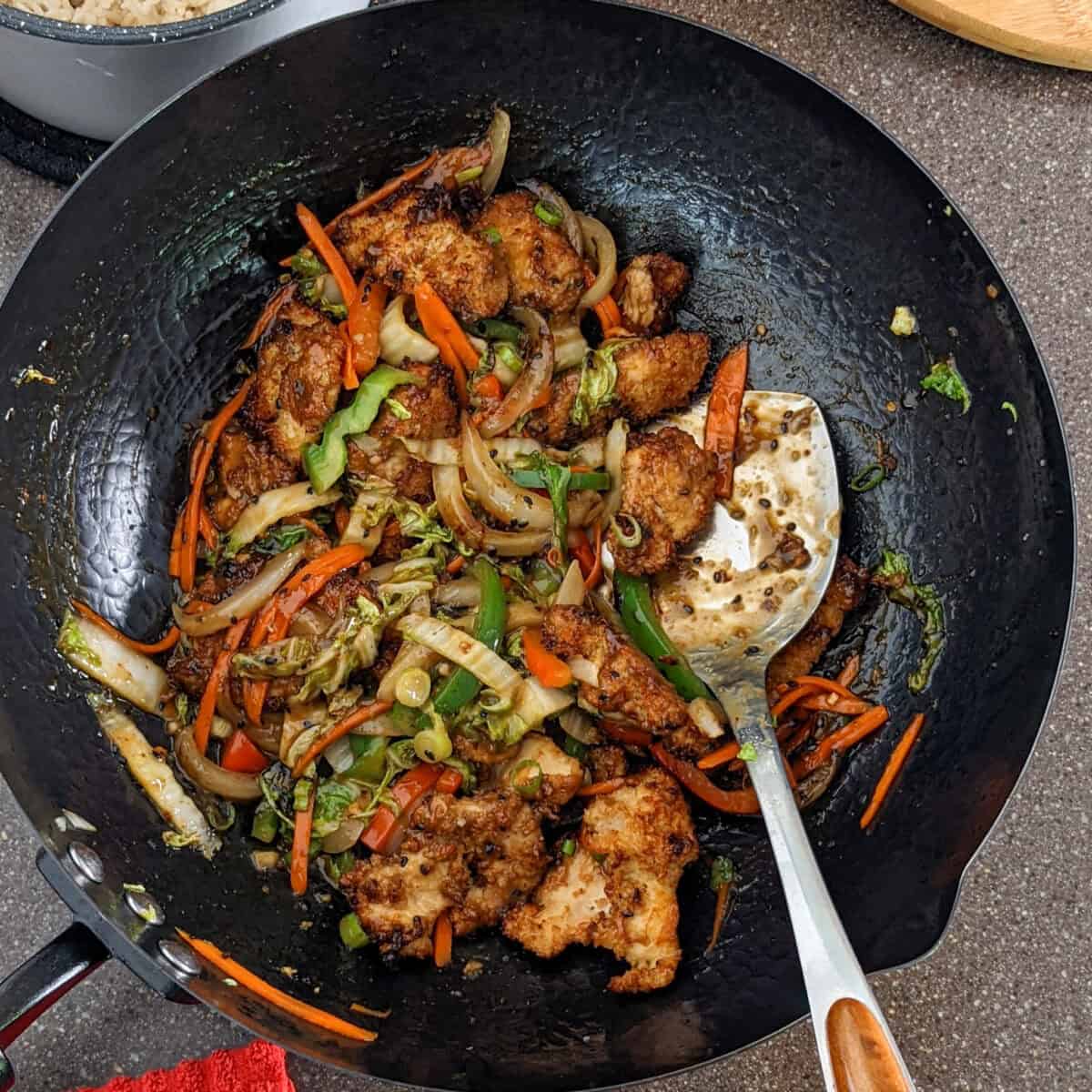








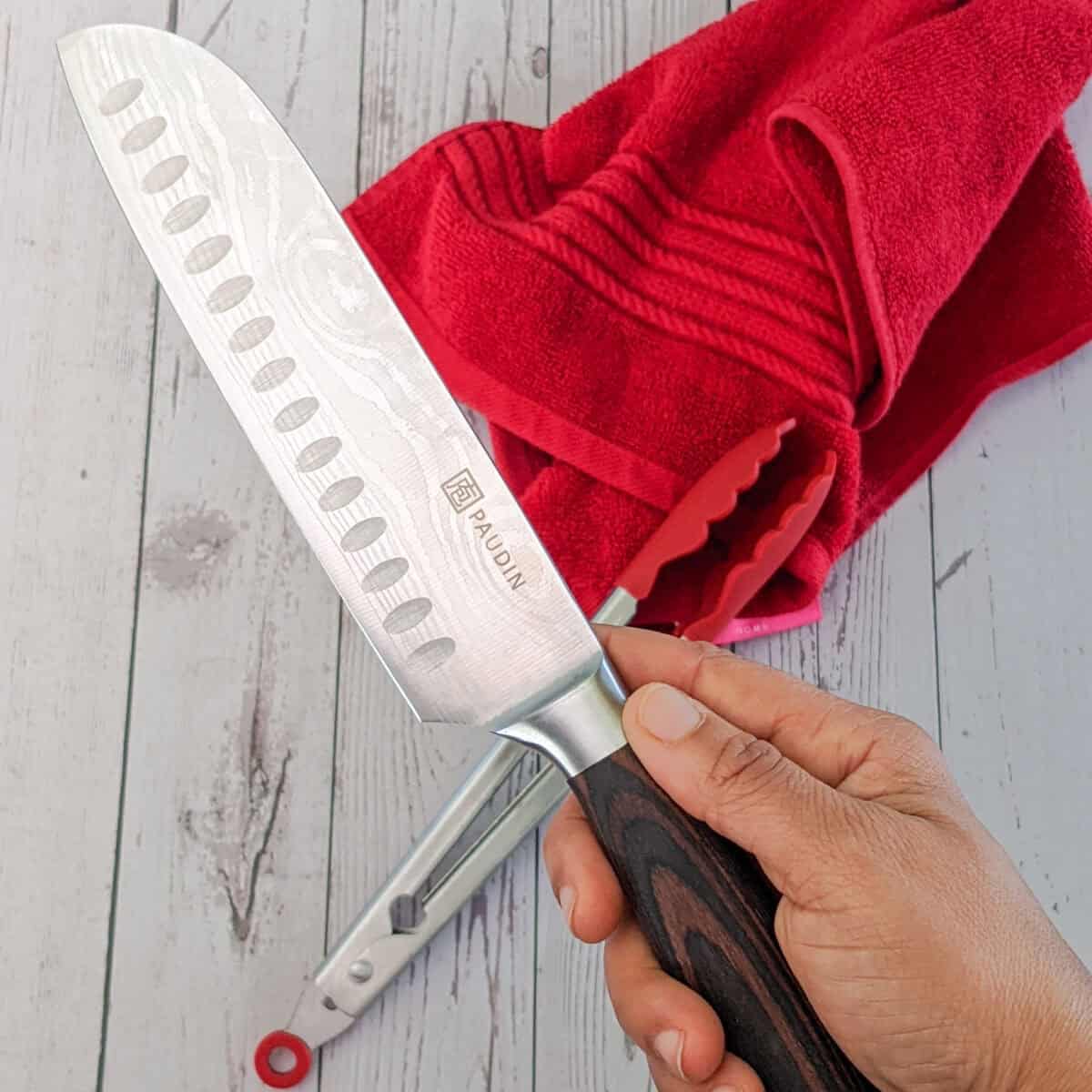

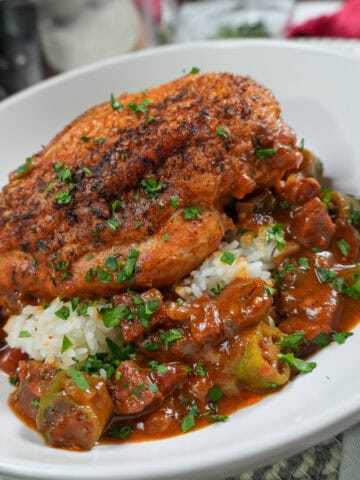
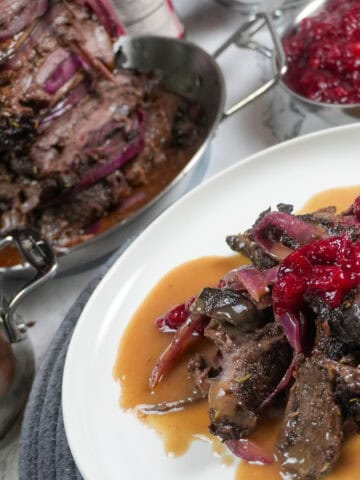
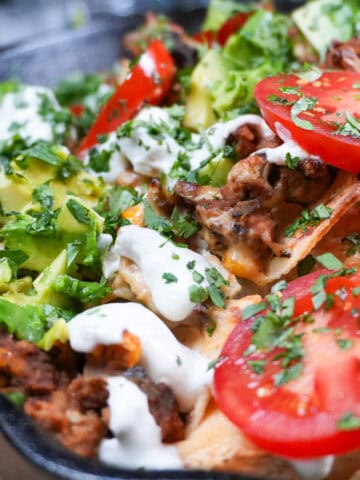
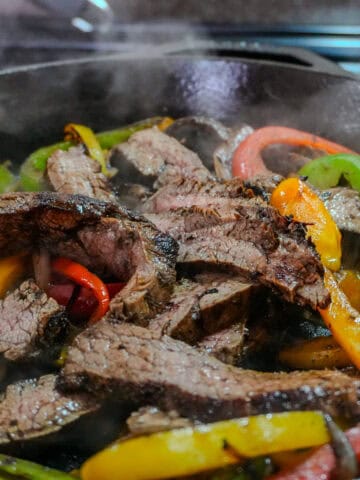
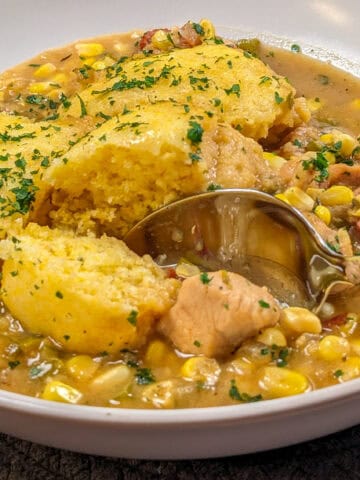
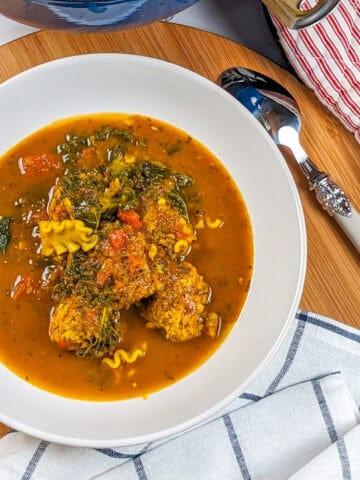
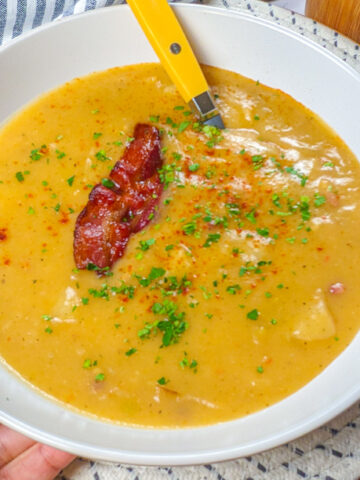
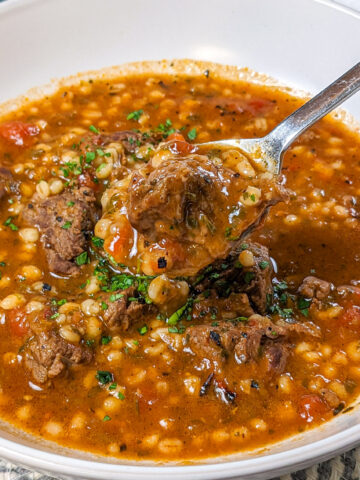
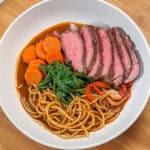

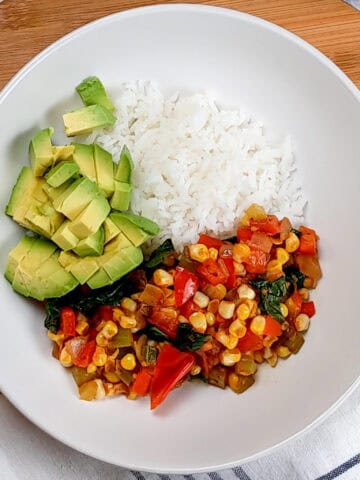
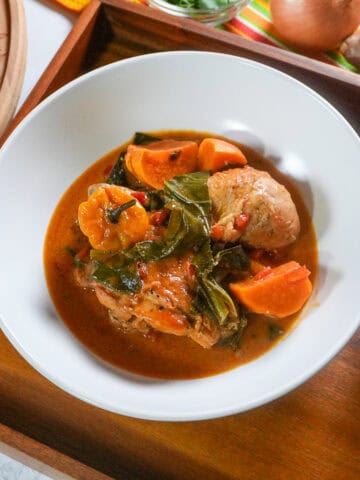
Leave a Reply